Magic of Morocco
February 27 - March 8, 2022
Mike and Judy Henderson
I'm going to leave the trip map at the beginning of each page so you can see where we are.

++++++++++++++++++++++++++++++++++++++++++++++
2/28/2022 (Monday) We were up early this morning. Breakfast is at 7am and we gather in the lobby at 8:30. No word on our luggage yet. We're getting along with clothes that were loaned to us by other members of the tour, and by washing the clothes we were wearing on the trip over.
We're going to tour Rabat by bus this morning and then depart for Fez.
Here we are getting ready to board the bus. It's a comfortable, modern bus, but has no charging plugs. Judy and Janet brought small charging batteries that we call "lipsticks" because of their shape. But the more recent iPhones have batteries that last a lot longer.
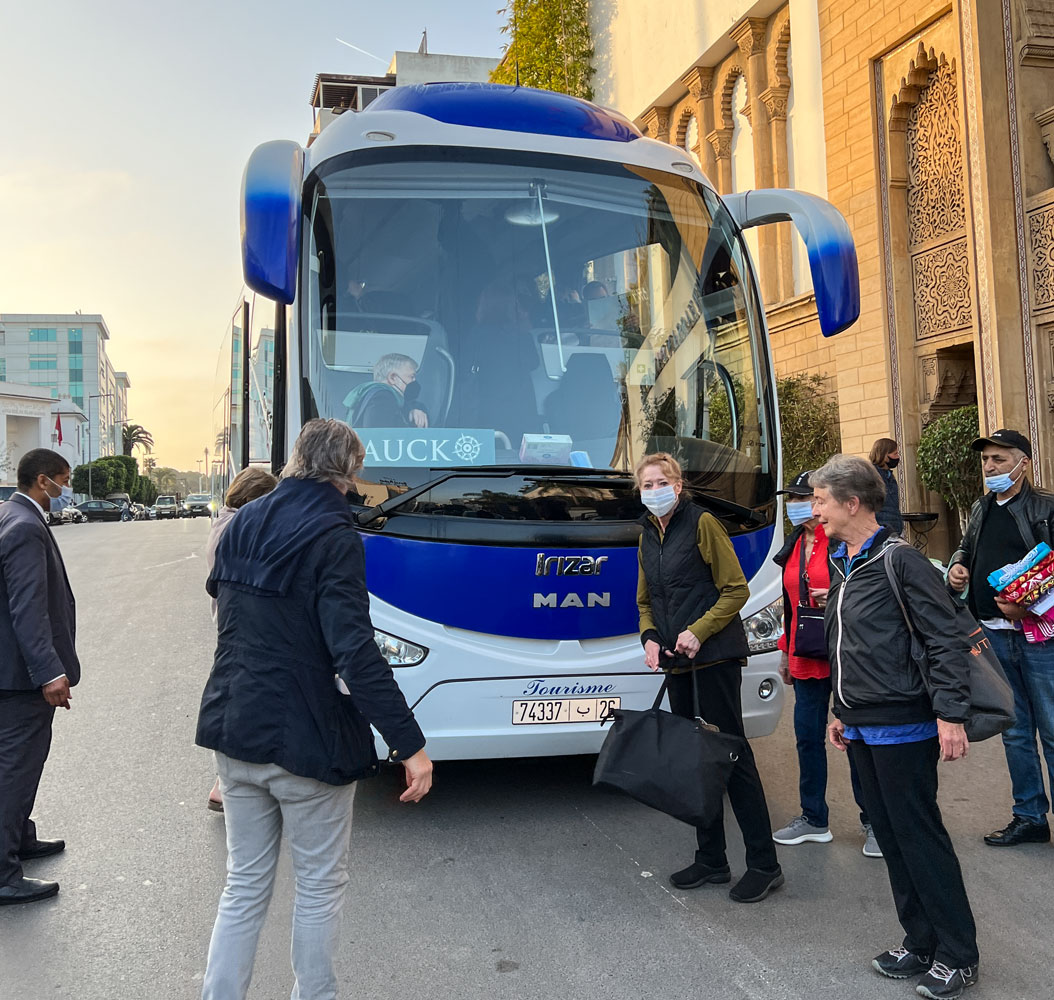
Here's Chris, the tour director, giving us the plan for the day. Right behind him is Nourdine, our Moroccan guide who will be with us for the rest of the tour. Note the clock - we were right on time:-) [Update: I recognized later that the bus clock was almost 9 minutes slow. So the time was really 08:41.]
The bus had Wi-Fi access which was valuable for those guest who didn't have an international plan with their phone. Judy and I have the ATT $10/day international plan. It's worth while because you get regular voice calls, texts, and Internet access, just as if you were home.
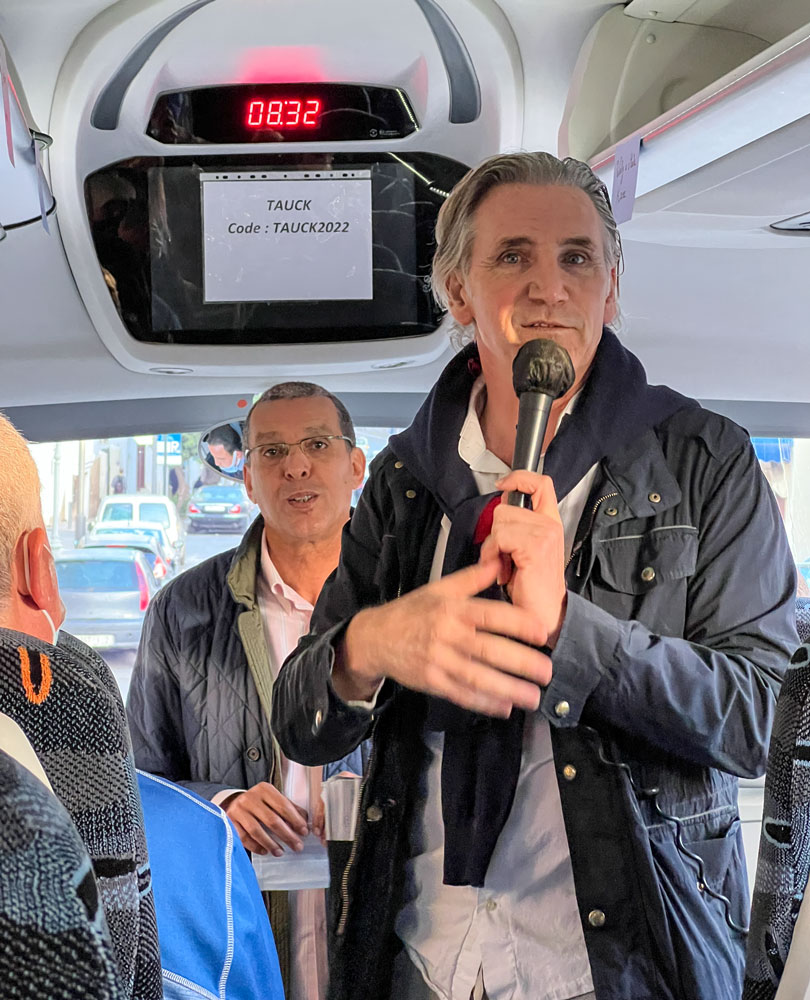
As usual, Tauck uses those small radios that allow the guide to transmit his/her voice to the guests. The problem with that system is the earpieces, which do not work for anyone wearing "over the ear" hearing aids. I bring a set of headphones that I can plug into the radio, but they are in my lost luggage.
Silversea had a much better system. I'm going to copy what I said on our Peru and Galapagos tour about the Silversea system.
[Start of copied text: For walking tours, Tauck has used a device carried by the tour guide that transmits his/her voice to receivers carried by the guests. The receivers have an earpiece that fits into your ear. But for people who wear over-the-ear hearing aids, as I do, these devices don't work. My hearing loss is not linear - I (like most people) have more loss at higher frequencies so if I remove a hearing aid and put in the receiver earpiece, I can't understand what's being said because all I'll hear is the lower frequencies. I need some way to get the sound above my ear, where the hearing aid microphone is. To get around this problem, I carry a headset that I can put over my hearing aids, high on my ears (Tauck never has headsets available for people with hearing loss, even though I've brought this issue to their attention many, many times).
Silversea uses an app on your smartphone called "iTourSmartGuide". The tour guide carries a transmitter that creates a Wi-Fi network. The guests will have earlier downloaded to their smartphone (either iPhone or Android) the iTourSmartGuide app and now bring it up on their smartphone.
The tour guide tells you the name of the network he/she's using, and you connect to that.
For people without hearing loss, they use whatever earphones they normally use, including Apple Airpods, to hear what the tour guide is saying.
But the important thing for people with hearing loss is that, if they have hearing aids with Bluetooth, the hearing aids work like Apple Airpods. I can hear the tour guide through my hearing aids without having to wear a headset. And I can hear with both ears which improves comprehension. I didn't ask what they do if a guest doesn't have a smartphone, but I assume they have a receiver they can supply to that guest. End of copied text.]
After every Tauck tour I send a note to Tauck about this problem but they never seem to address it. The minimum they could do is provide some earphone devices that will fit above the ear, where the hearing aid microphone is located on "over-the-ear" hearing aids.
The primary goal today is to drive to Fez, but before we leave Rabat we're going to visit a few sites in the city. The first place was the palace grounds. Here's one of the entrances (where we entered). Morocco is a Monarchy with an elected legislative body. But the King has overall authority and can override legislative actions. The position of King is hereditary.
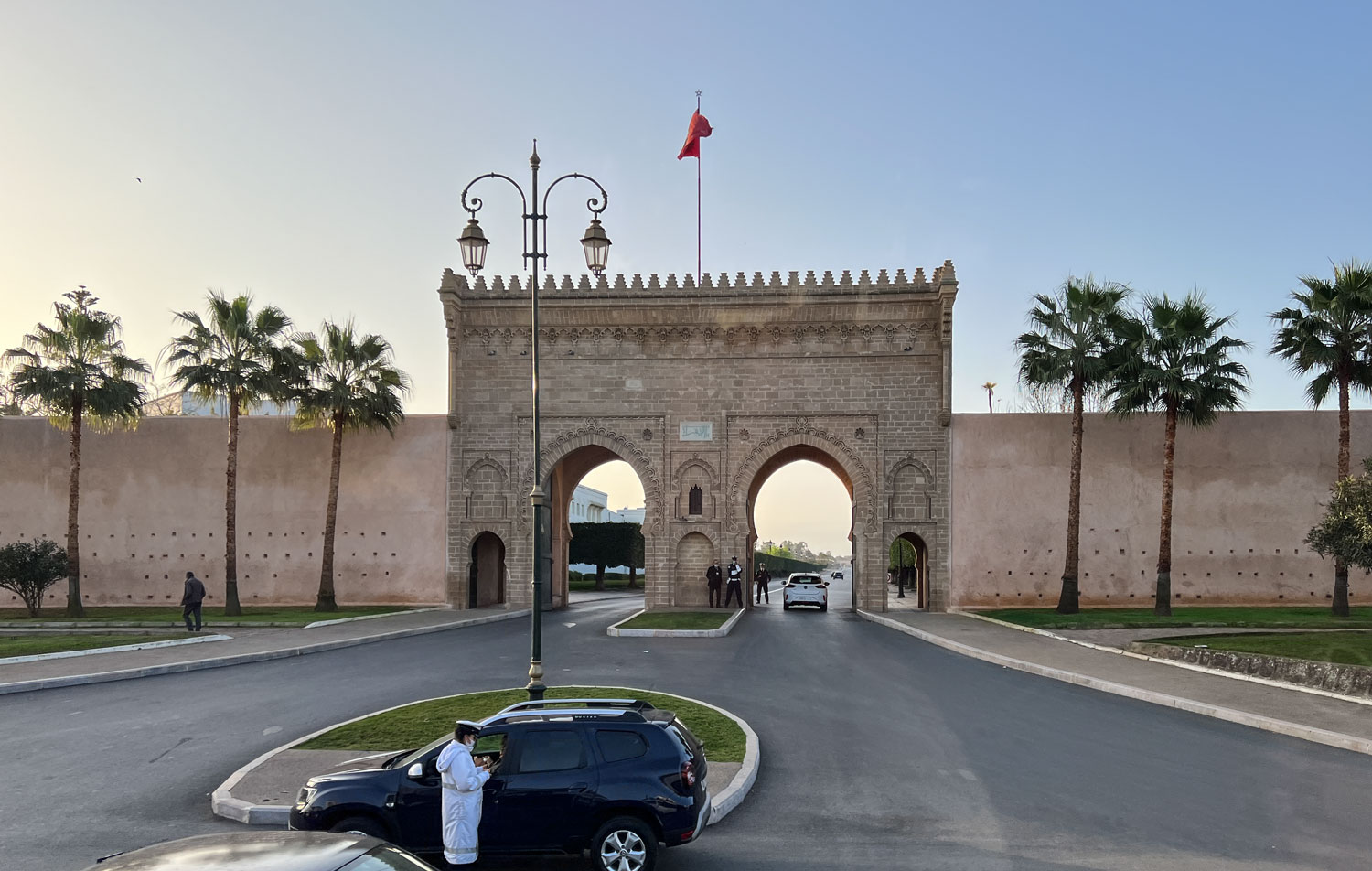
I'm afraid I don't remember a lot about the various buildings that the guide talked about.
After leaving the palace area, we drove along a road that gave us a view of the Mohammed VI tower that's being built. It will be the highest building in Africa at 250 meters. The dividing line between Africa and Asia is the Red Sea and the Suez Canal, so the oil kingdoms along the Persian Gulf with their giant buildings are actually in Asia.
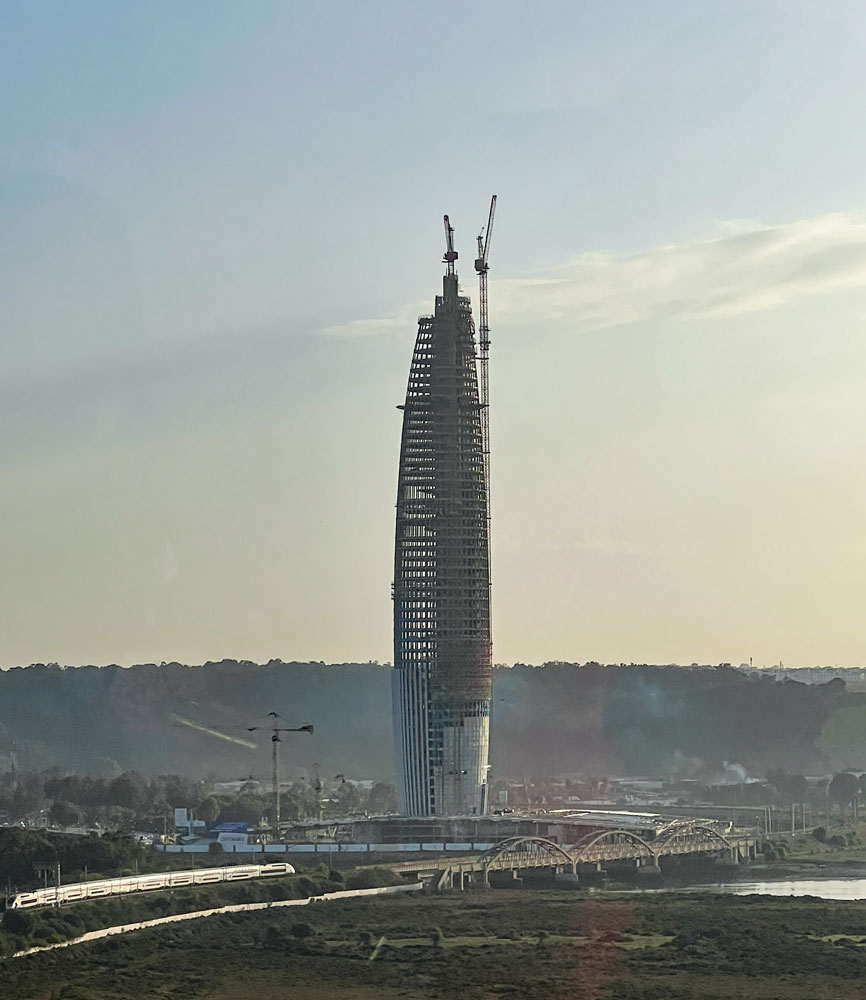
We also passed the Grand Theatre of Rabat, also under construction, but planned for completion soon. It was designed by Zaha Hadid, a British-Iraqi architect. She was the first woman architect to receive the Pritzker Architecture Award (in 2004).
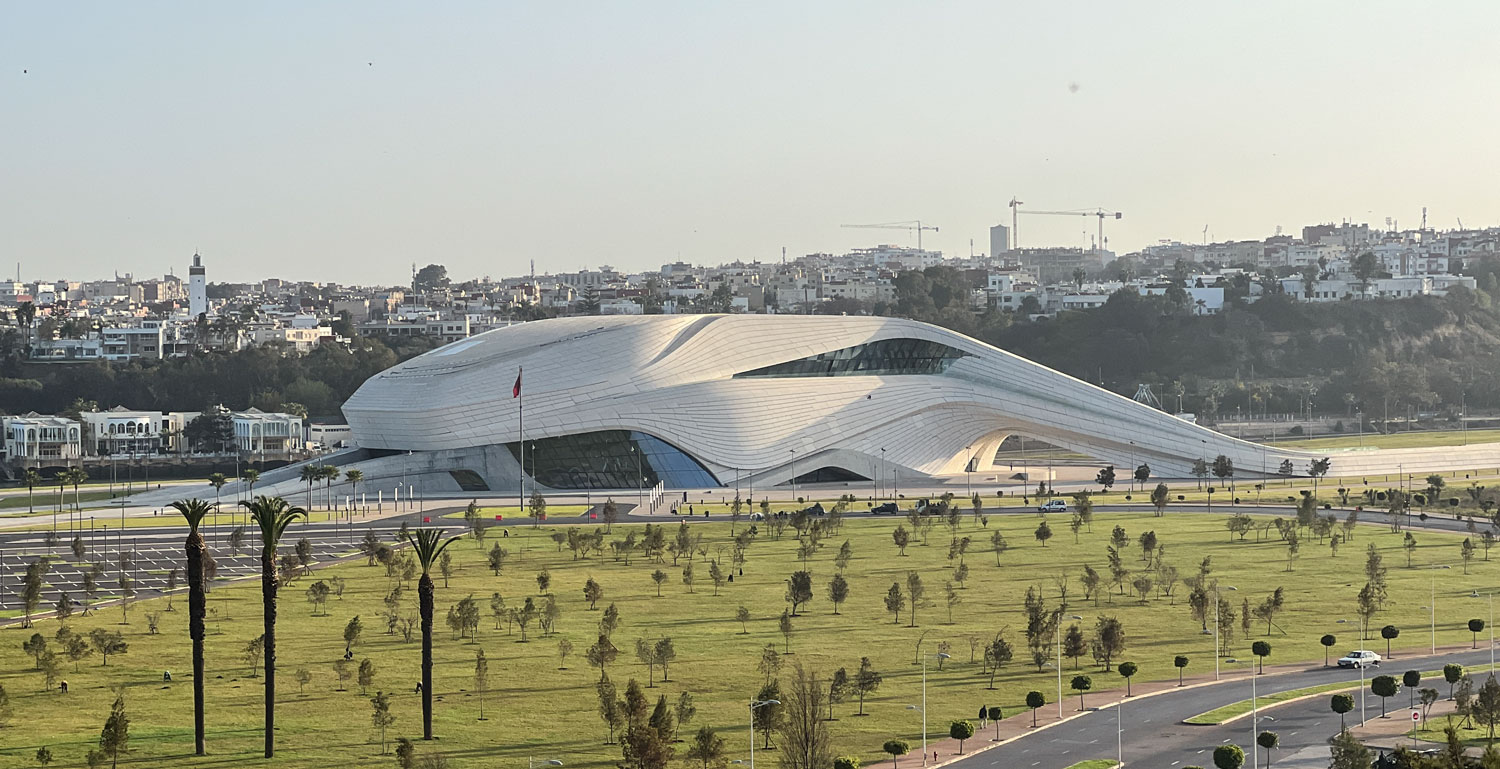
We went to the site of the ancient Hassan Tower. Built at the end of the 12th Century and really never completed. It was supposed to be part of a huge mosque that was never built.
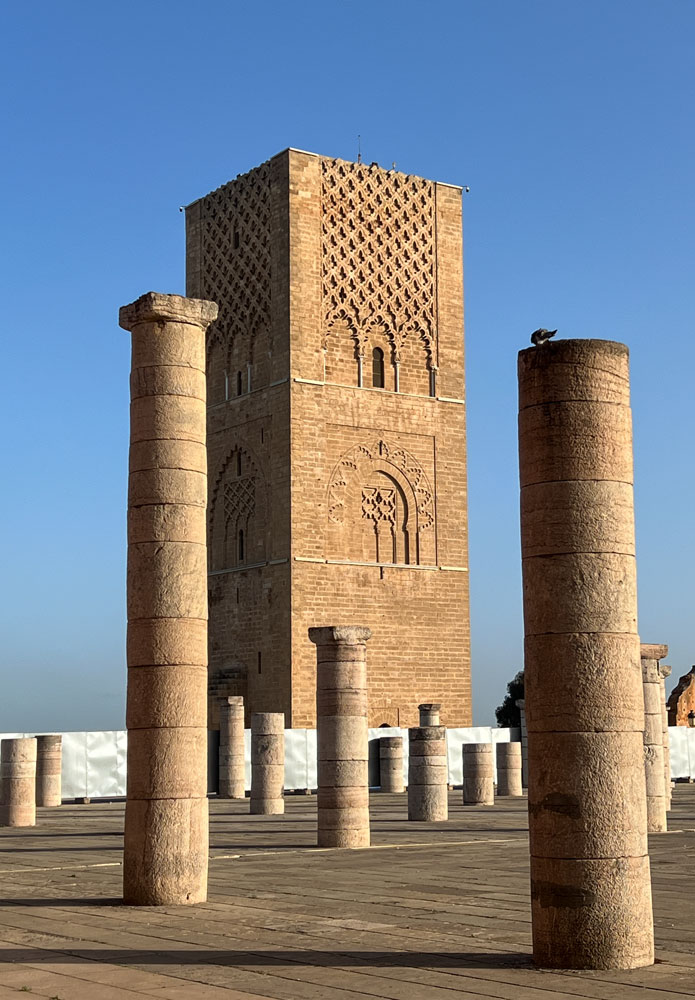
The mausoleum of Mohammed V is located at that site. Mohammed V served as Sultan of Morocco during the "Protectorate" days of the country, from 1927 to 1953, and then as King from 1957 to his death in 1961. Here's his mausoleum.
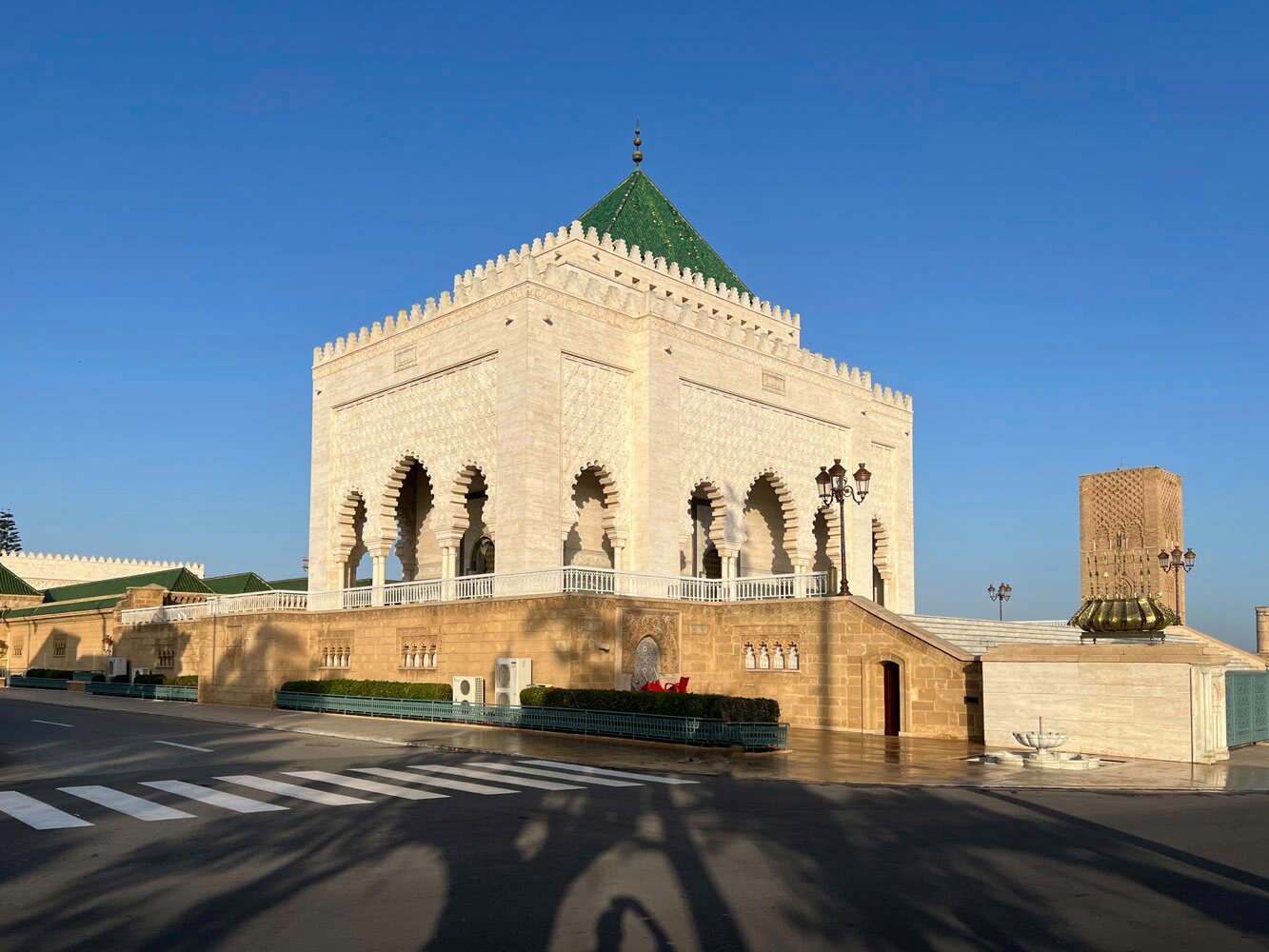
The entrance to the area around the tower has two ceremonial guards, each on a horse. I understand the horse and guard are on duty for two hours and then are replaced. I felt a bit sorry for the poor horse who has to just stand there for two hours.
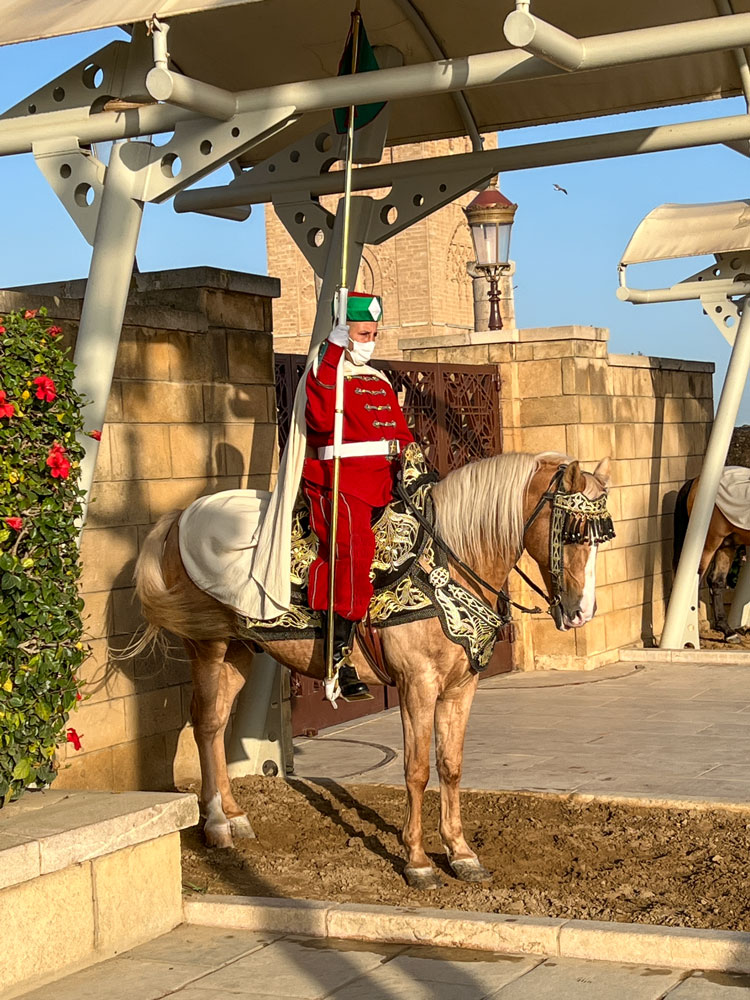
Then we drove to the area of the Rabat Kasbah, or fortress. Judy, Janet and I had visited this area yesterday on our walk.
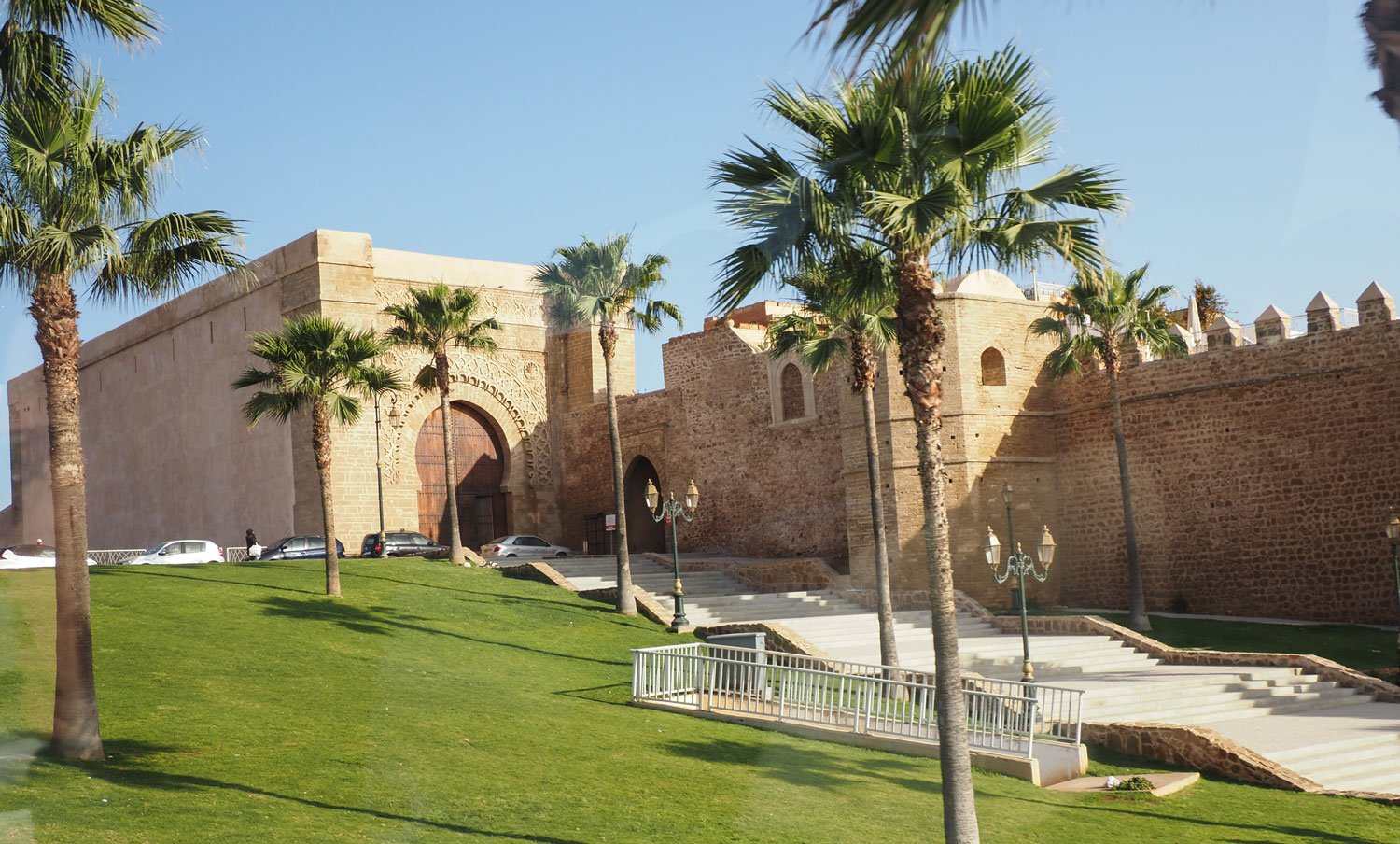
Here's a beautiful woman in the Kasbah.
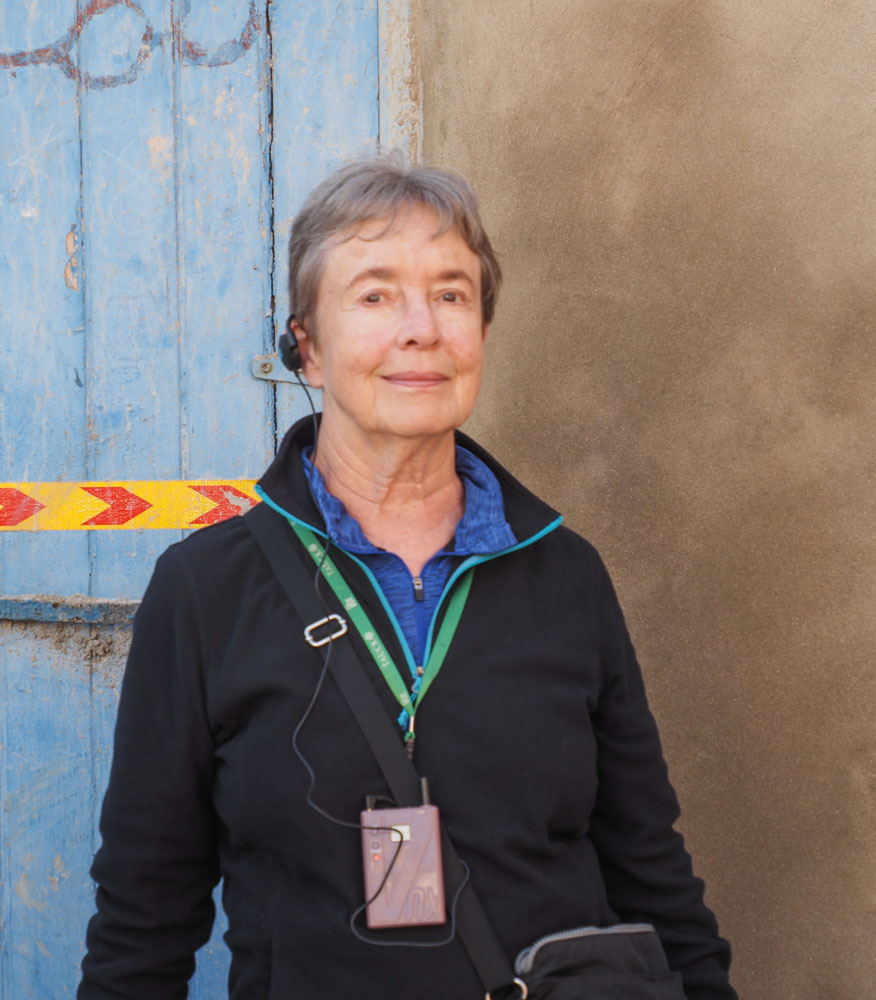
The renovation on the walls is part of a UNESCO project, and work must be completed by a certain date or the funds are lost. Many projects around the country were delayed by Covid restrictions on work.
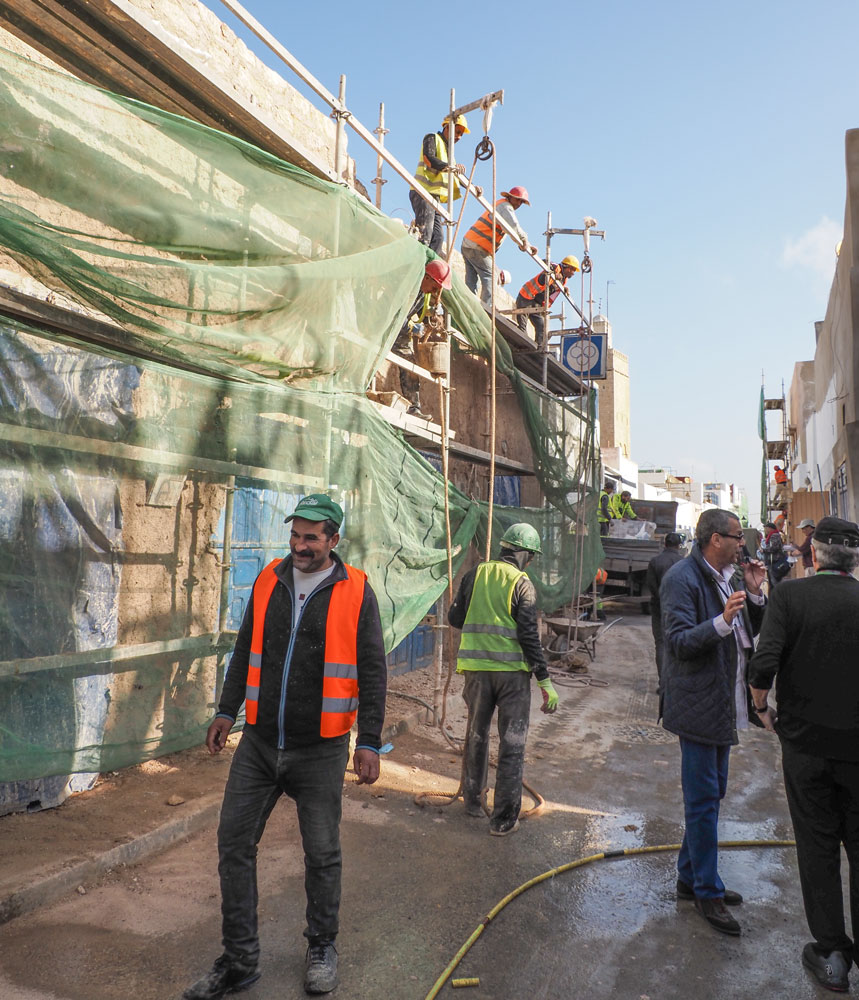
Cleaning up the old stones to re-use them. A lot of manual labor. Note the lack of eye protection. OSHA would have a fit about the safety practices, or lack of them:-)
When photographing a person, it was polite to ask their permission, either with a gesture, or with the offer of a small payment. Some people were not happy about being photographed in any case. When you went to take their picture, they would hide their face, or rub their thumb on their fingers in the universal symbol for "money".
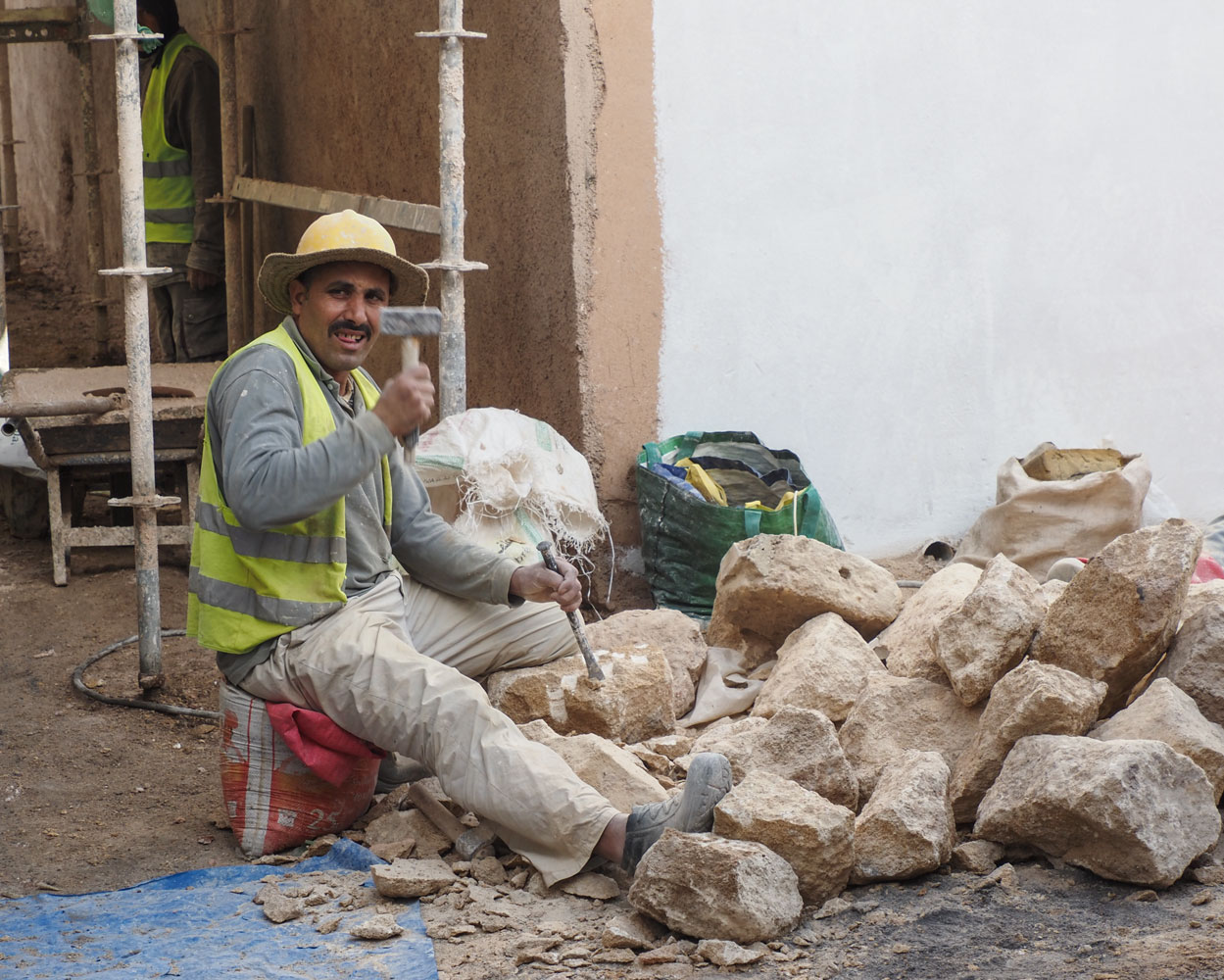
We walked through the Kasbah to a patio area where we could see the river and the ocean. It's difficult to see in this picture, but the band directly below the buildings is another huge cemetery. Cremation is not permitted in Islam so a lot of land is dedicated to cemeteries.
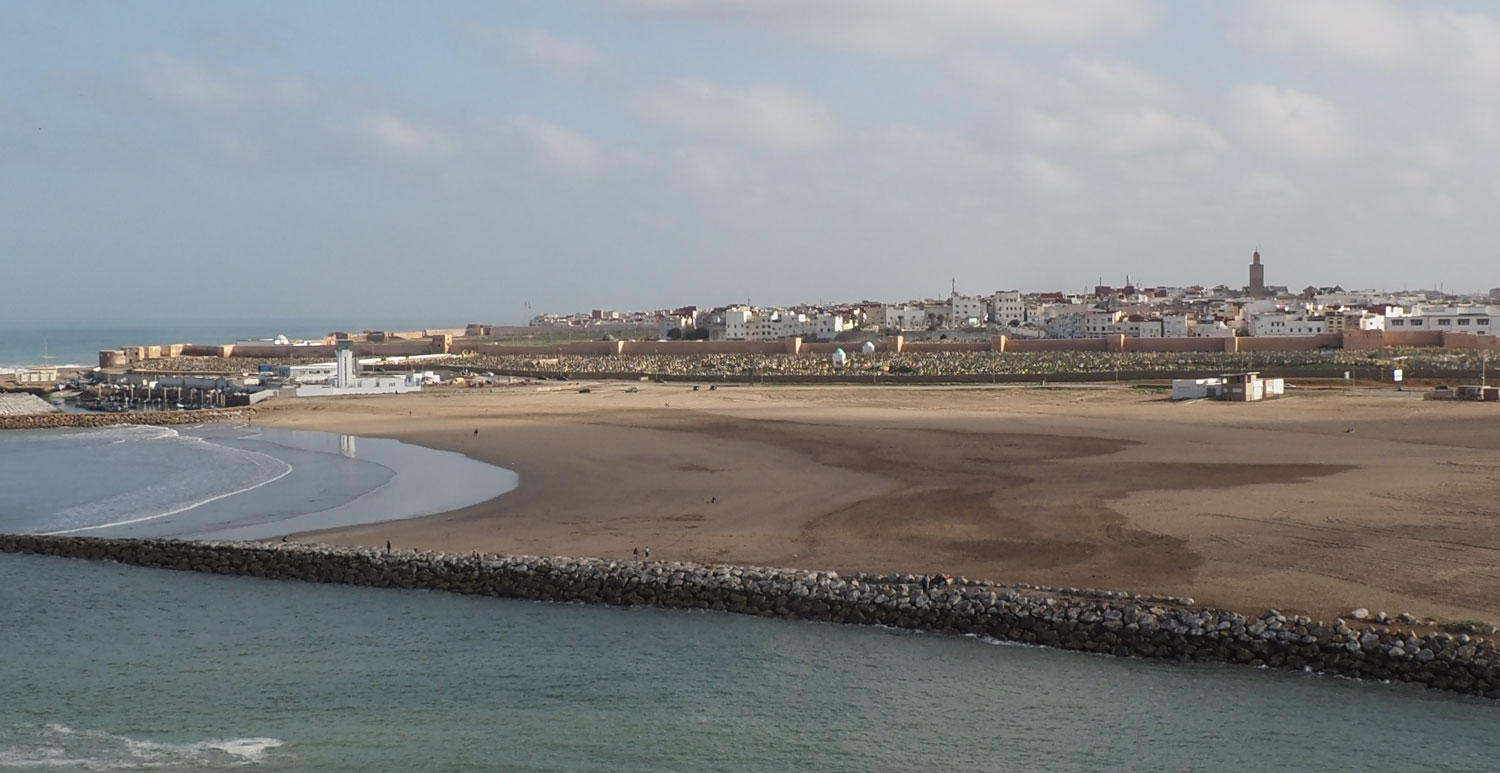
We could see the Rabat lighthouse.
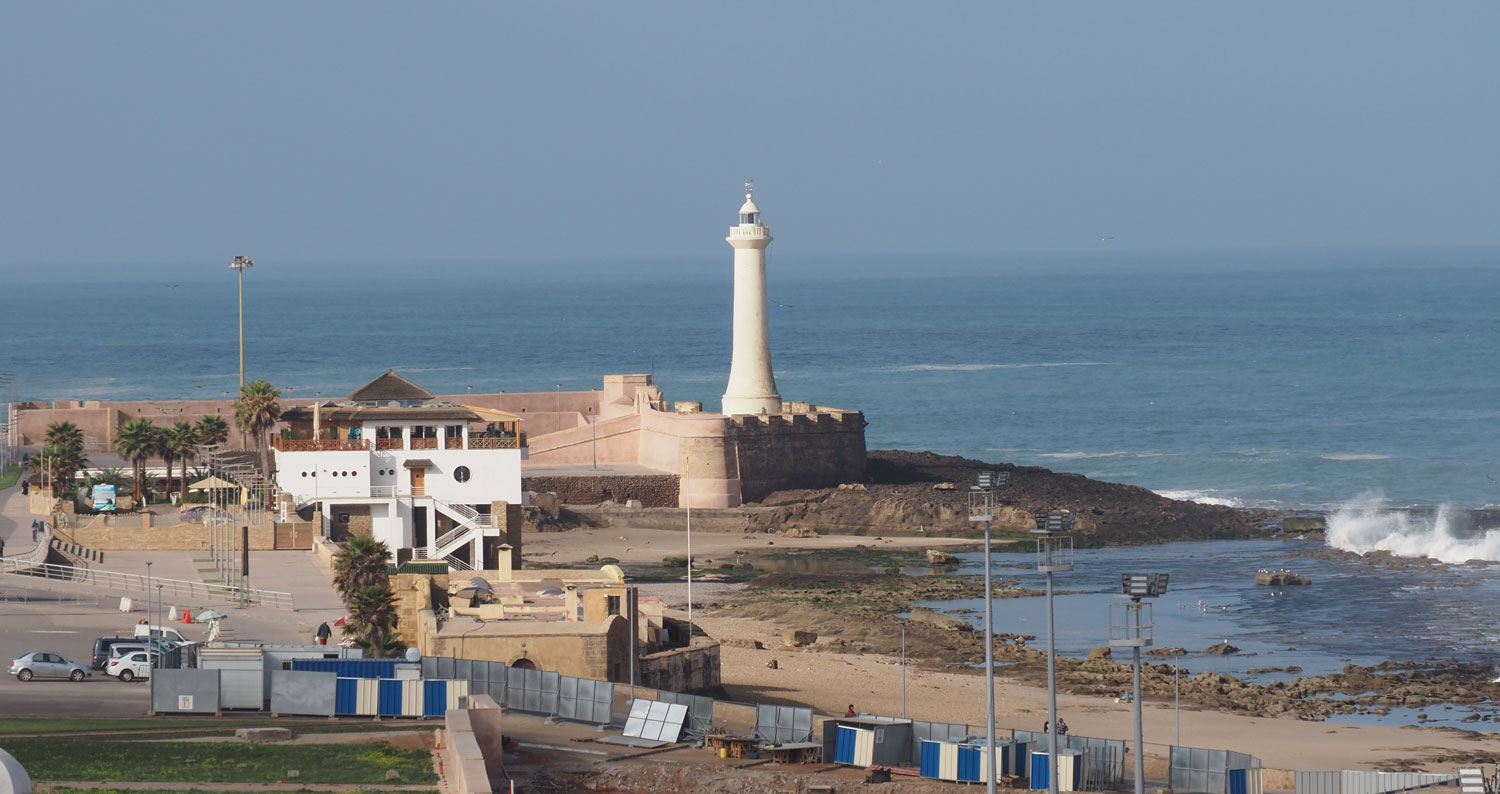
Surfers were taking advantage of the waves, even close to the jetty.
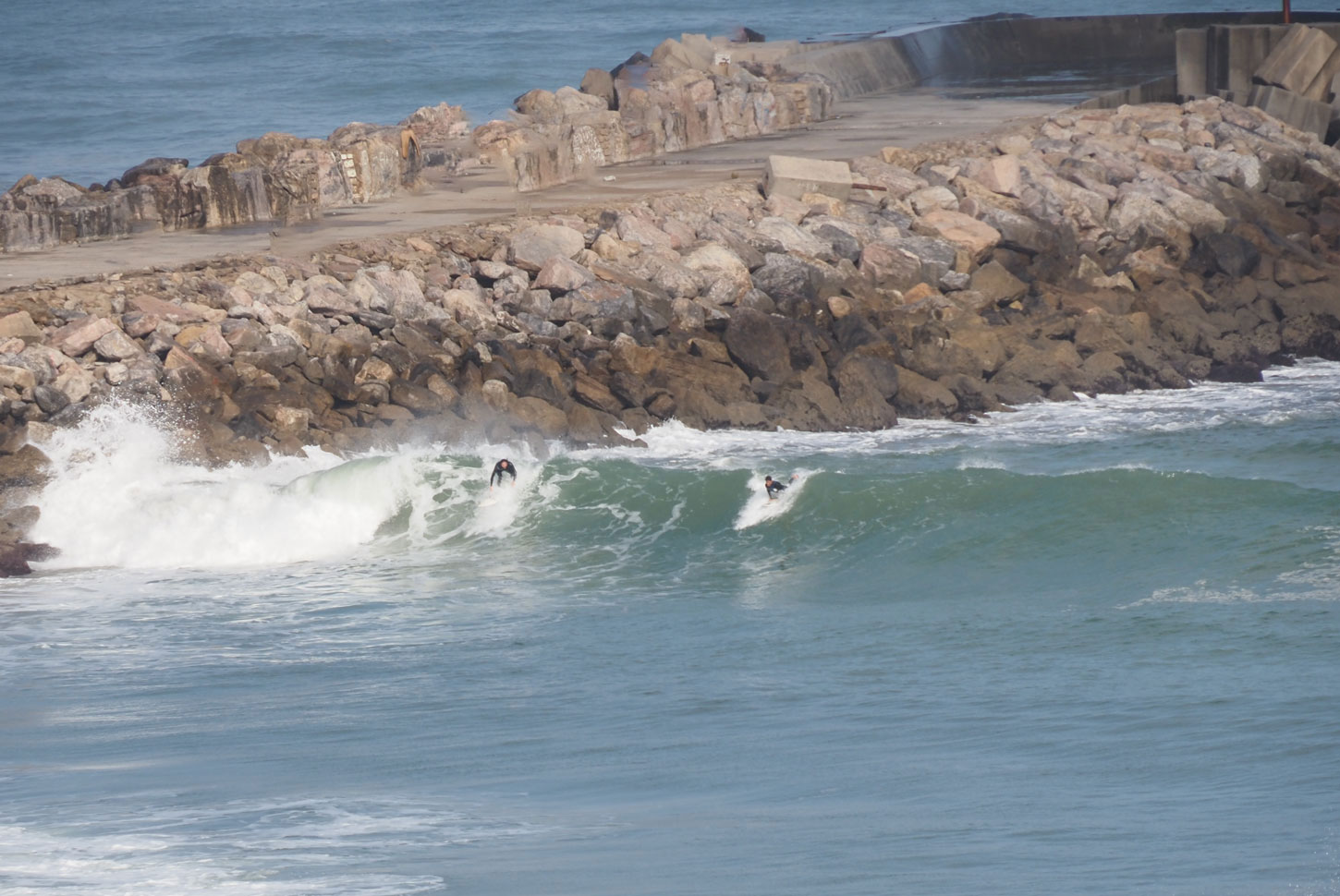
Then we departed Rabat and headed for Fez. On the way, we stopped at a winery (in a Muslim country!) for a tour and lunch. Morocco exports some of its wine, but a surprising amount is consumed by locals. There is a fairly large wine industry, and about 80% of the wine is actually consumed locally. The government doesn't mind having the wine industry even though it contradicts Muslim law, as long as it pays its proper taxes.
On the bus ride to the winery Chris reported that our luggage had been found and was being shipped to Casablanca.
Here we are in the winery. It appeared to be a standard, modern winery.
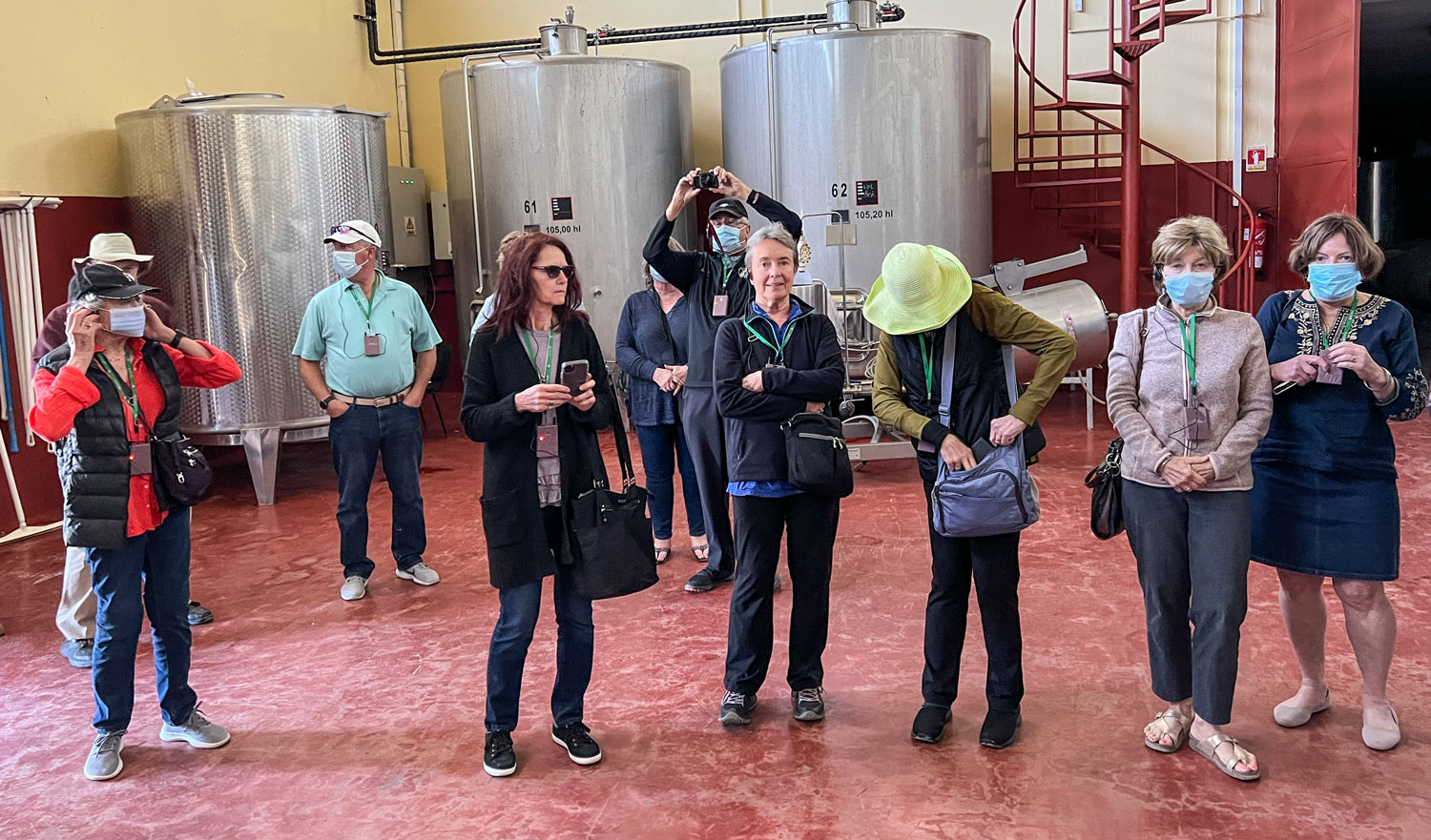
After the tour, we adjourned to a house on the property for a wine tasting and later for lunch.
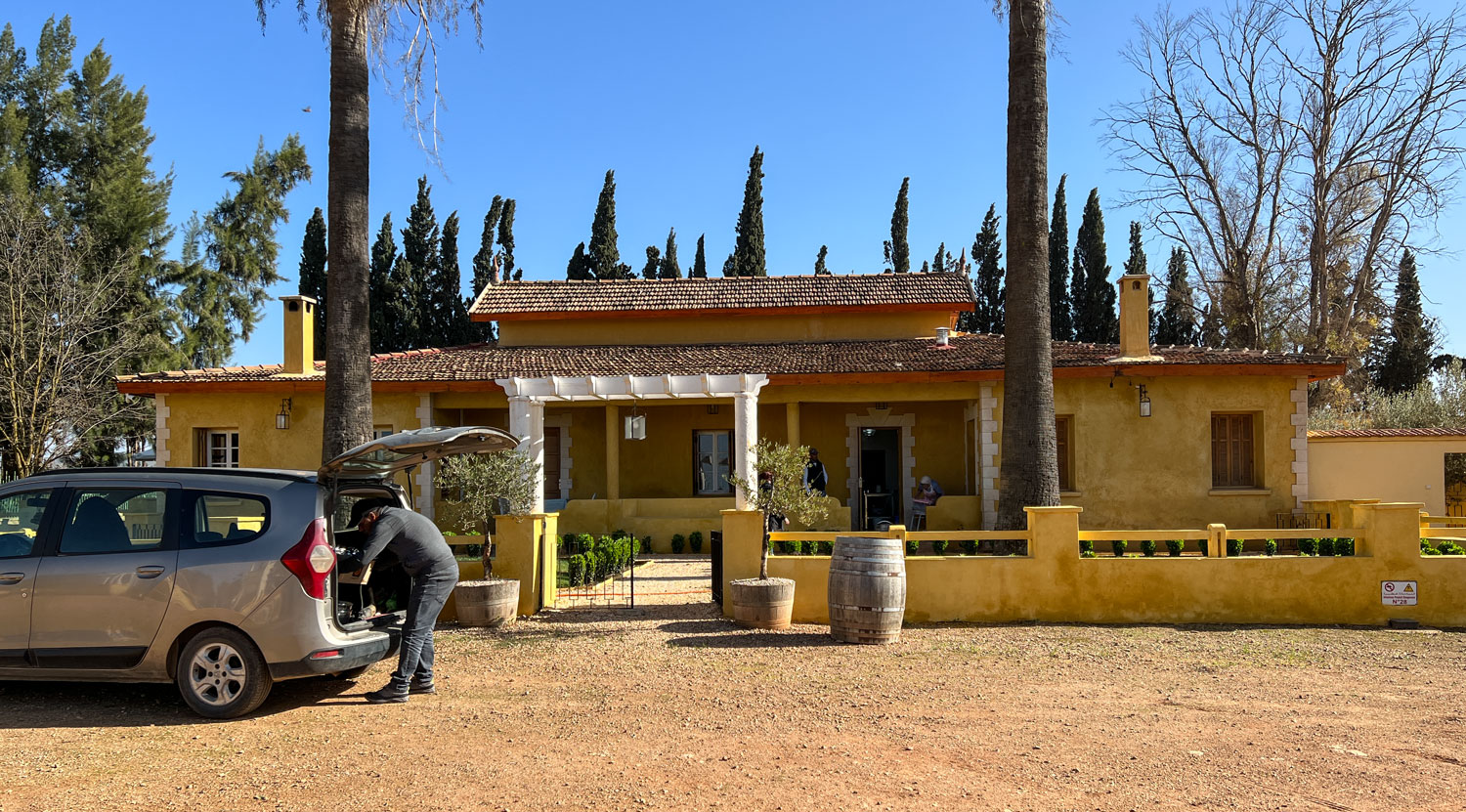
Here's a picture while we were tasting some of their wines. I didn't take a picture of lunch but it was fairly standard Moroccan dishes.
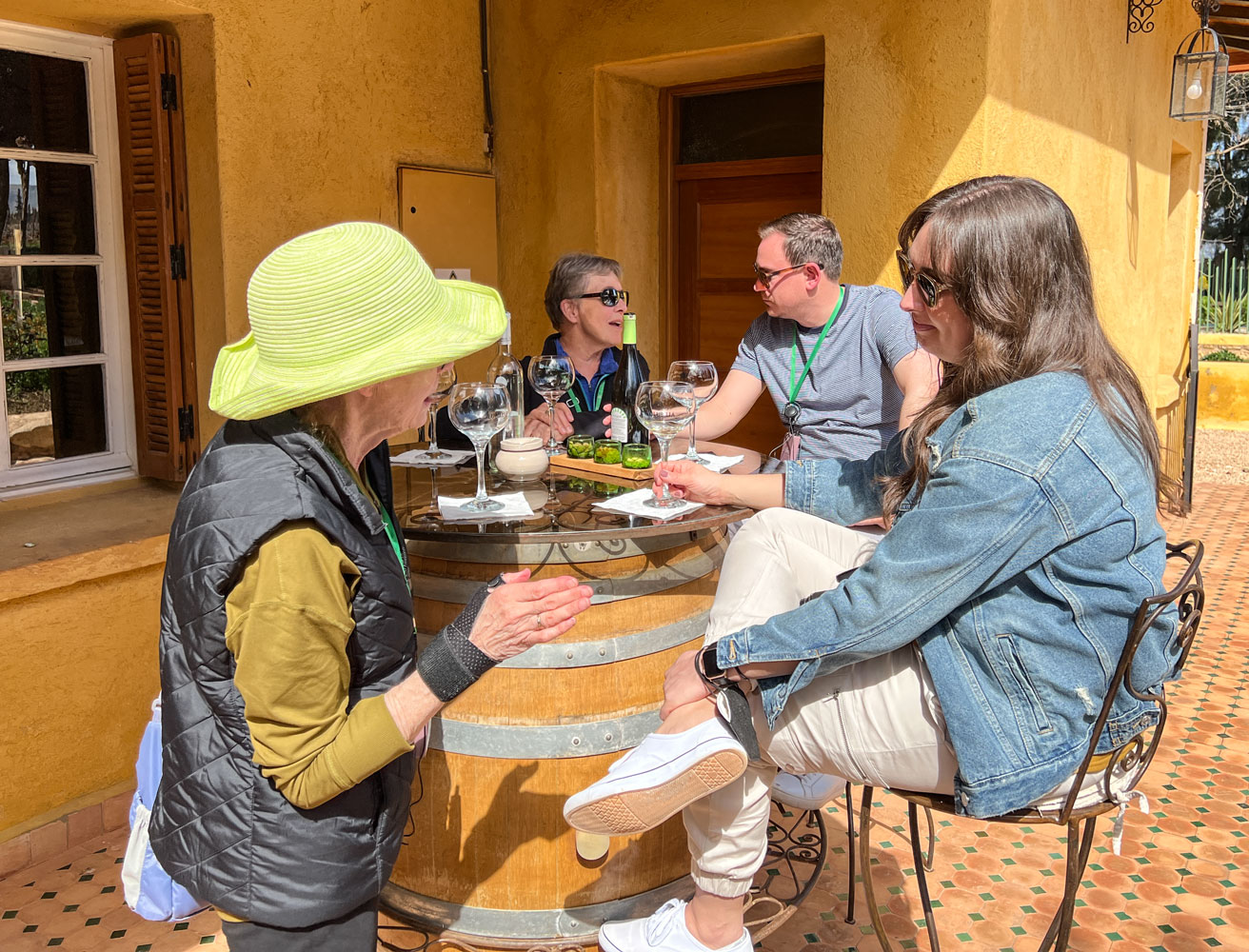
After lunch we continued on to Fez and the Palais Faraj Hotel. It's a nice hotel but has a few issues: The hotel appears to have been created from an old structure, perhaps a residence. [Update: You can see the history of the hotel here. It was the home of the Bensouda family, built about 1900. Here's an interesting story about early families.] The rooms and hallways are not well illuminated and there are many changes of height in the floors (single steps of maybe four to six inches, easy to trip on). The elevator is old, small and slow. But the rooms are nice, the hotel is clean and well maintained and the staff has been excellent. It was a fine example of old-style Moroccan architecture, and was beautiful.
In reviews I read before the trip, people complained about slow Internet access, but it appears they've updated their system - I got 38Mbps down and about 15Mbps up, which I consider very good.
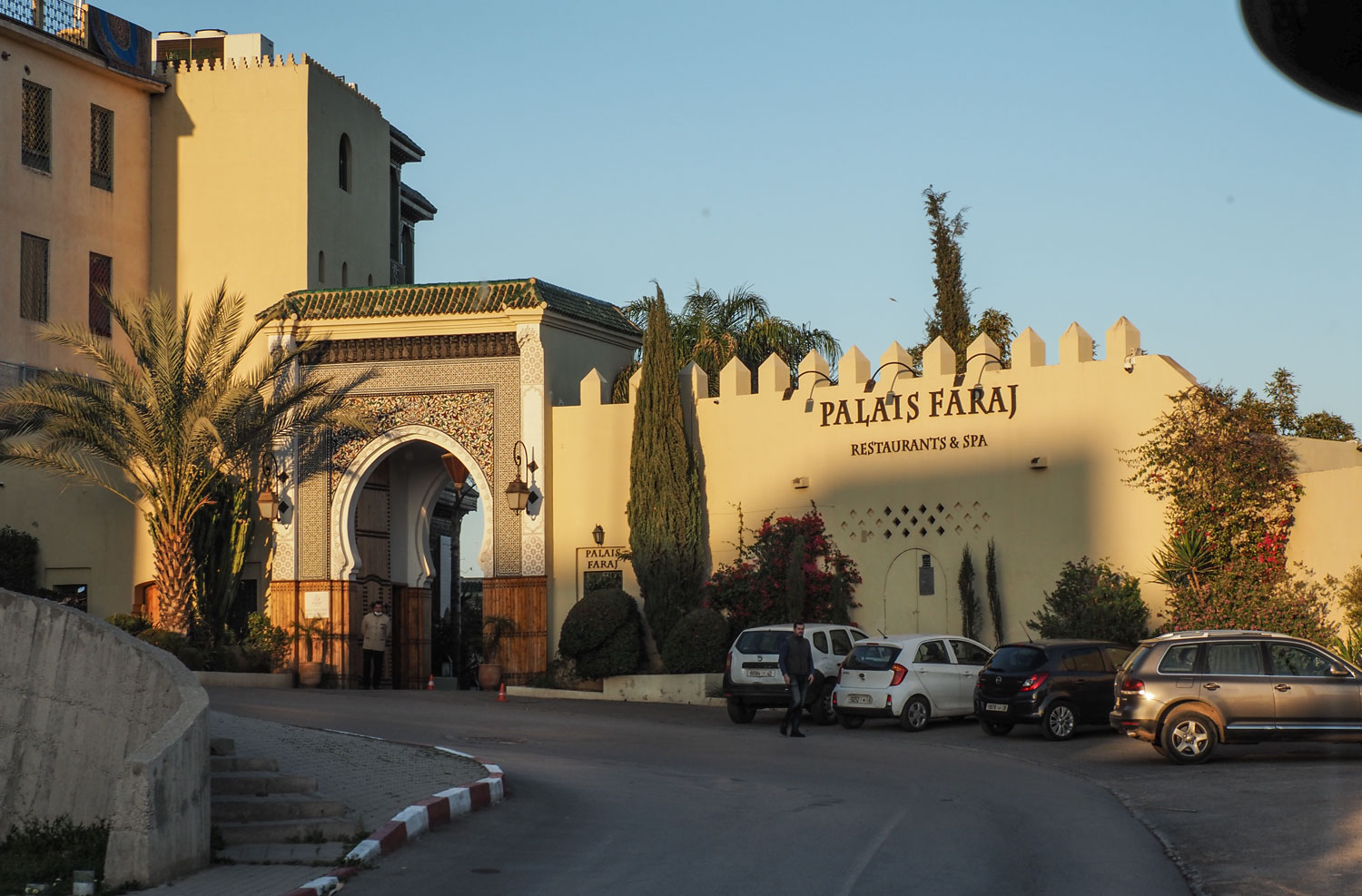
The important thing that the hotel provides is an overview of the Fez medina (technically, medina means "city" but seems to be generally used to mean the "old city".). I came to Fez as a blank slate - with no knowledge of that area or the city. After visiting the medina, I realized that what I was seeing was the way a city developed "organically" over centuries. That is, it appears the medina developed with no overall plan or control. I'm guessing, but it appears that people built buildings mostly where they wanted to - and for their own needs. The streets are narrow because that's all that was needed when the city developed. But before electricity, the city must have shut down at night because you couldn't see to even walk in those streets. Old cities in Europe were probably similar.
Water and waste must have been a real problem. It would be interesting to learn how they dealt with that, and how that affected the development of the medina. And who paved the streets? There must have been some overall management of the development. I'm sure that fire and earthquakes also shaped the city and weeded out the poorly built buildings. There are so many questions that it's overwhelming.
While we saw a small part of the medina, I didn't really come back with an understanding of the city - just the memory of some of the sights, smells and sounds of the medina. But I'll do more research and perhaps it will lead me back to Morocco one day. Tauck keeps us very busy - as they should - but it doesn't leave me any time to do any research on the web, or even to work on this blog.
Tomorrow, we'll do our visit to the Fez medina and I'll try to capture a part of the experience in photos.
But back to today - We had a late lunch at the winery so we skipped dinner and went to bed.
++++++++++++++++++++++++++++++++++++++++++++++++++++
3/1/2022 (Tuesday - four days without our luggage) Chris (the tour director) and Jennifer (our travel agent) are working the issue of our lost bags. Chris reported that the luggage had arrived in Casablanca and was scheduled for shipment to Fez. He was going to try to get them to keep the luggage in Casablanca so we could pick it up when the tour went to Casablanca. Chris has loaned me some pants and a shirt, and Marta, another guest, loaned me a shirt. She also loaned both Janet and Judy some shirts. Her generosity was overwhelming.
We're going to tour the medina of Fez today. But first, we went to the Jewish cemetery. At one time Morocco had a significant number of Jews, about 280,000. Many were descendants of the Jews who were expelled from Spain in 1492. But life was not easy for a non-Muslin in Morocco and many emigrated to other countries. After the formation of Israel in 1948, many emigrated there. Then, after Morocco became independent from France in 1956, many more emigrated to Israel, Europe, Canada and the US. Finally, after the Six-Day War in 1967, most of the Jews who had remained in Morocco left. Today, there are only a small number of Jews in Morocco, perhaps 5,000 in the entire country.
Here's a plaque giving some information about the cemetery.
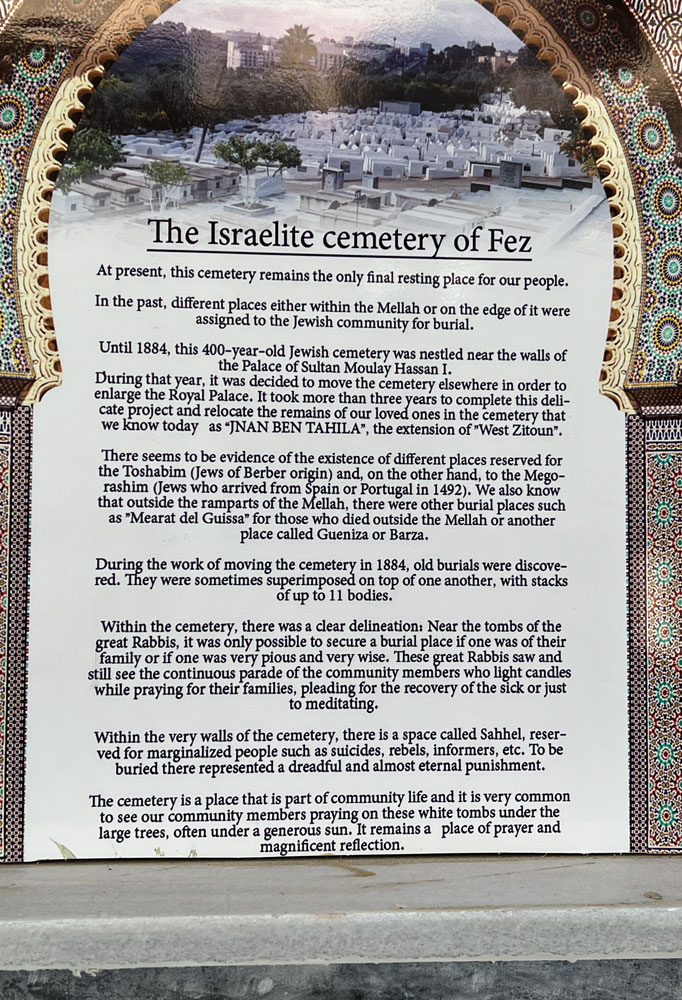
And a view of some of the graves.
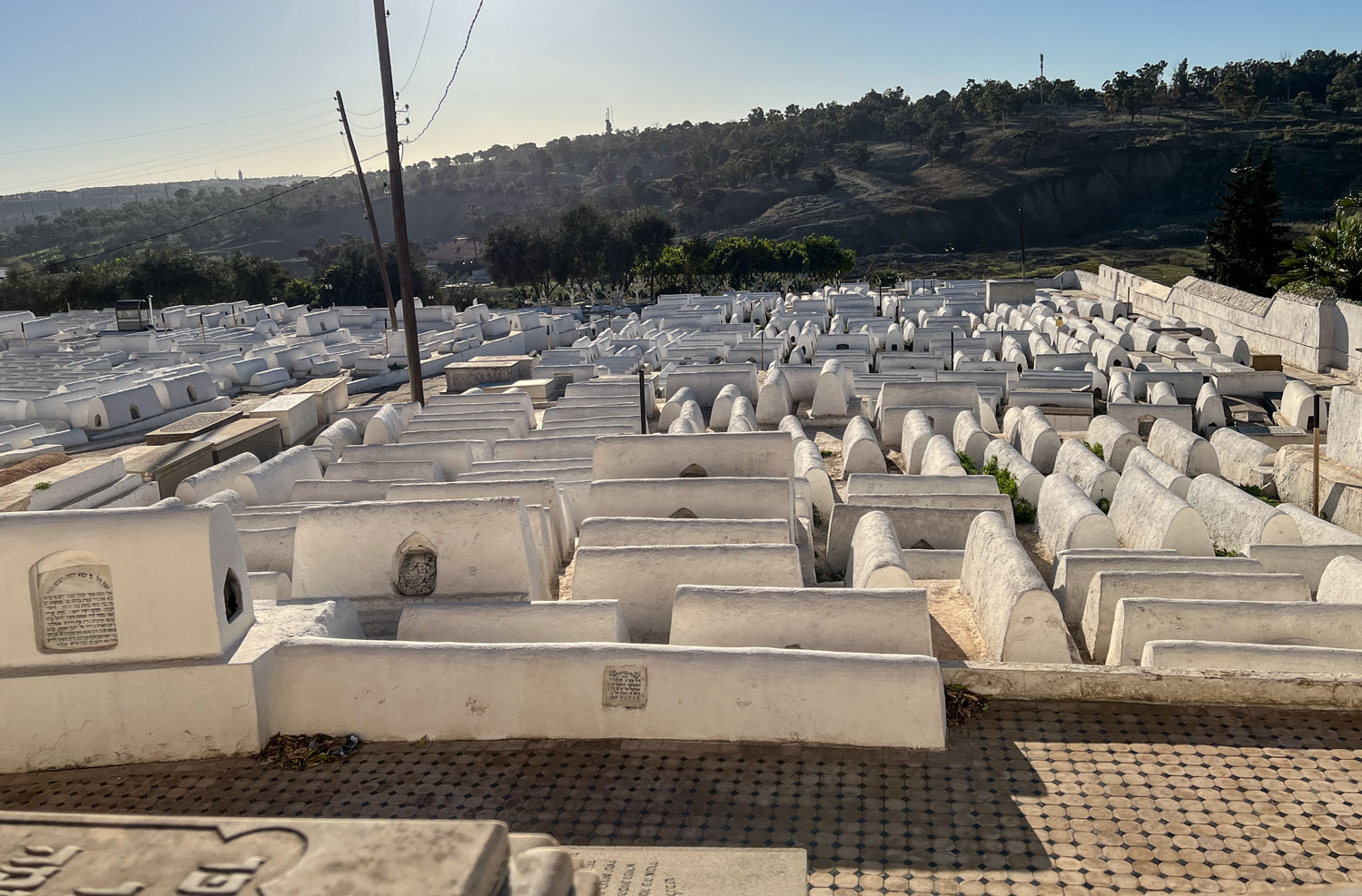
Then we entered the more dense area of the medina. These photos don't even come close to showing what it was like, but perhaps they can give you an idea.
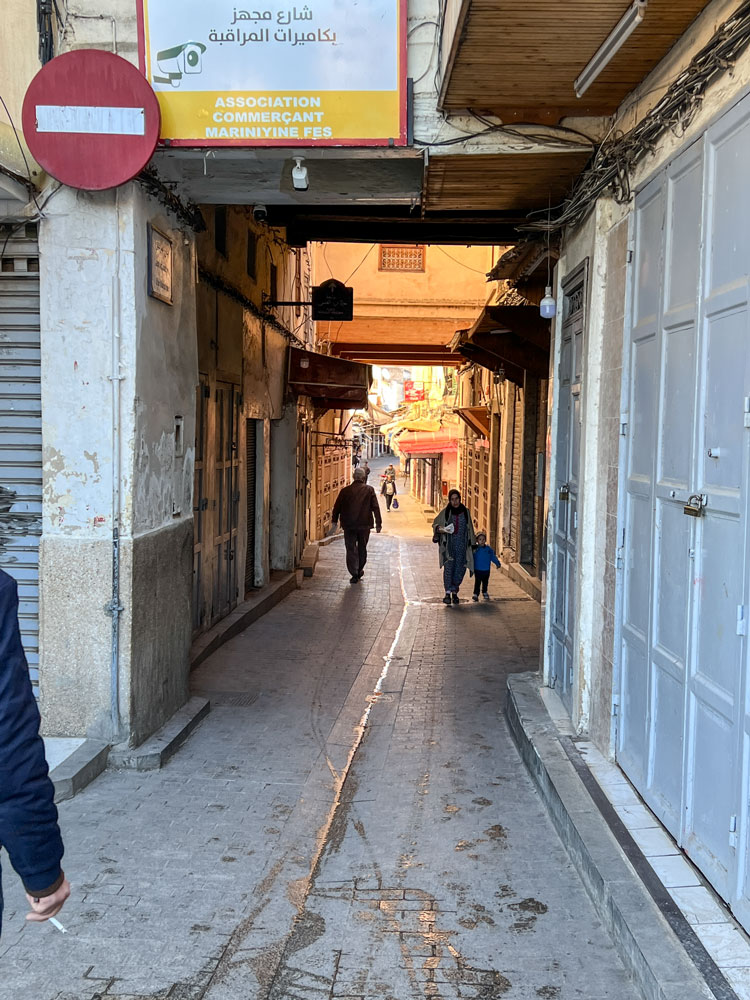
There were many, many small stores like this one, selling all different kinds of things. Not tourist oriented, but products for the residents.
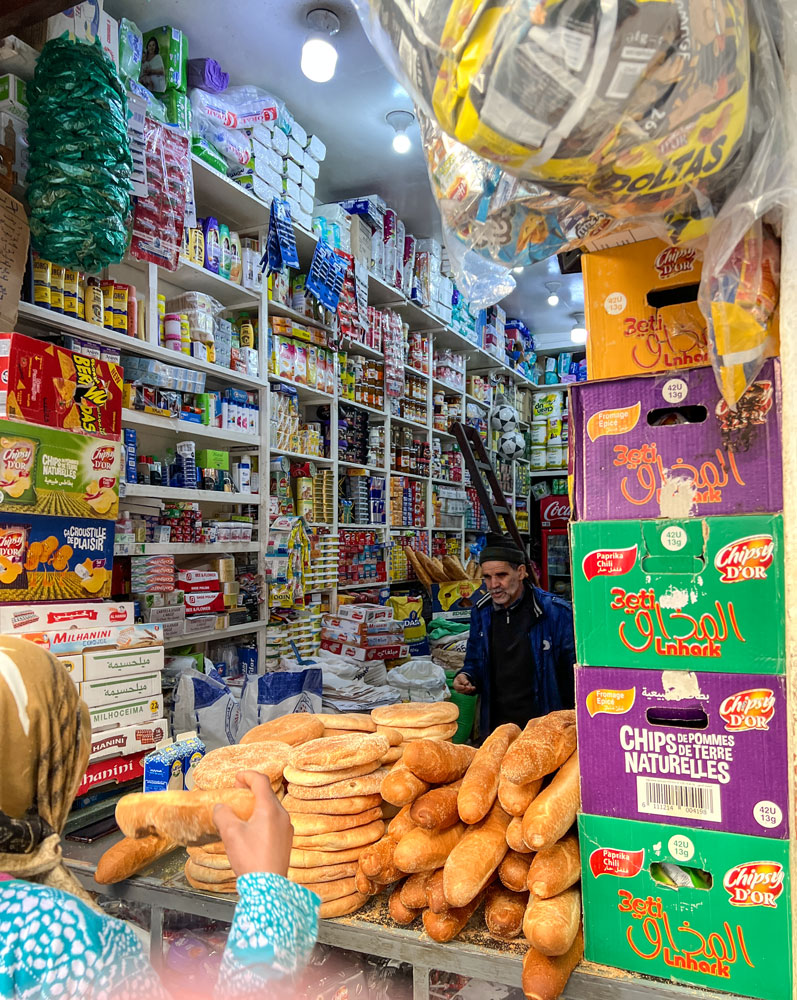
Most streets were like this, with enough room for a donkey (with a load) to pass and a person to walk. Nothing is brought in except by cart, donkey, or by hand. Daily needs are sold in numerous shops, many seeming to offer similar goods. It's difficult to understand how they can all stay in business, but shopping is generally done in small batches, and on a daily basis. In some shops you could buy bread dough, and take it down a few shops to have it baked. It would be complicated to figure it all out, if you were a stranger.
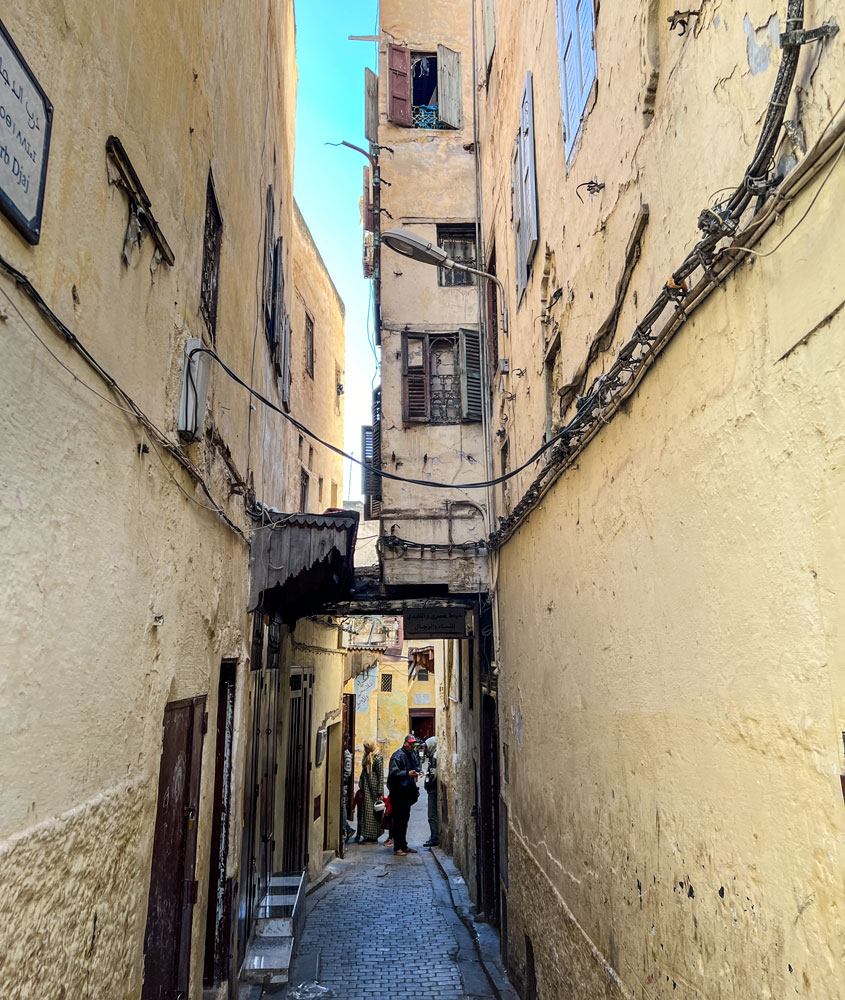
Judy shopping for men's underwear for me.
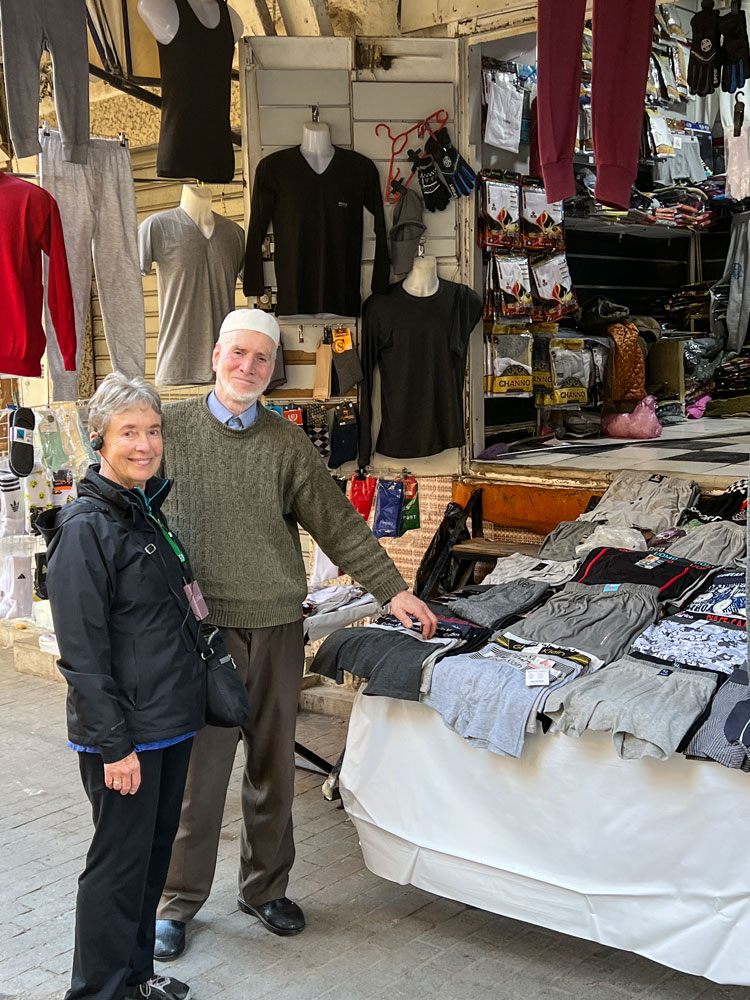
The street, here, was fairly wide. Why? I have no idea. That's just the way it developed.
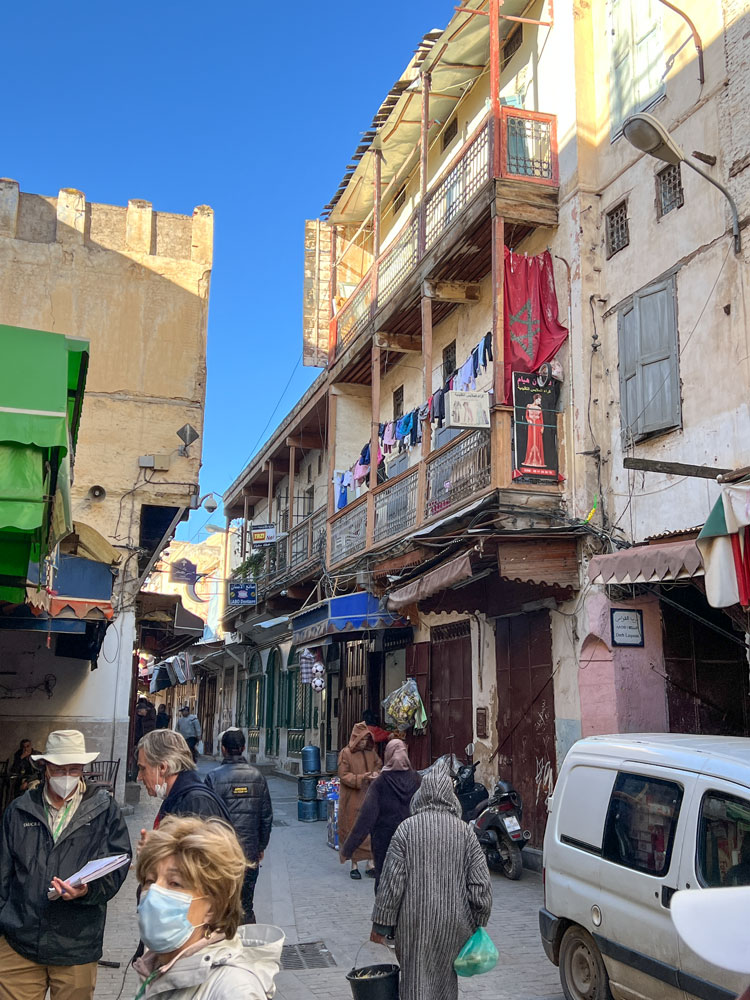
One final street scene. We were fairly early so there were a limited number of people out.
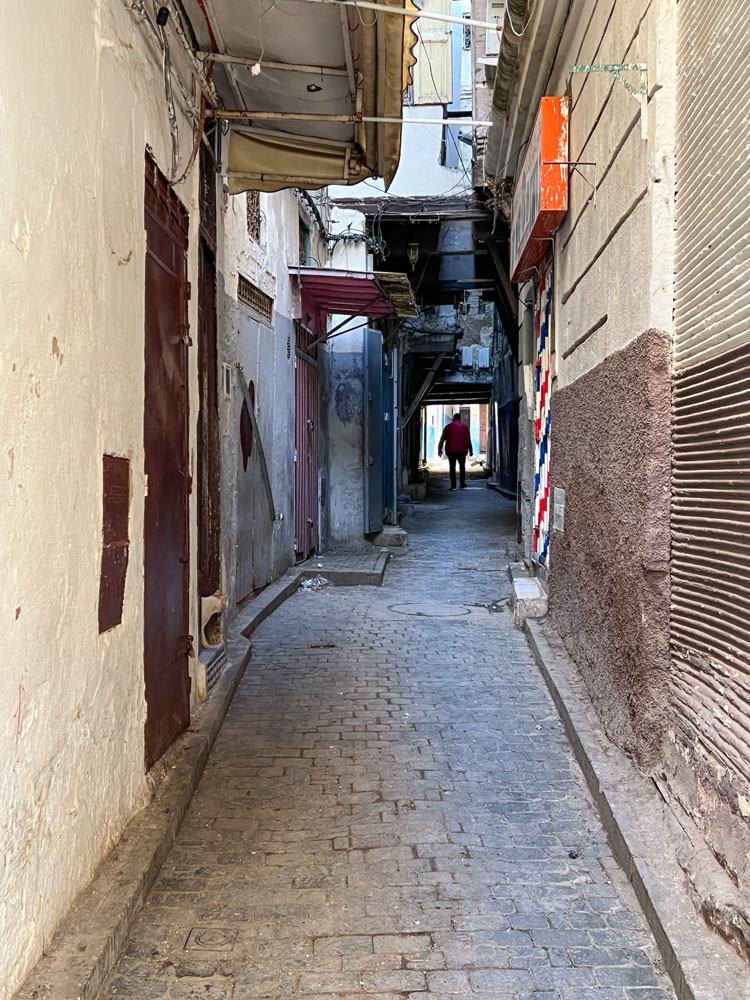
Eventually, we wound our way to the Aben Danan synagogue.
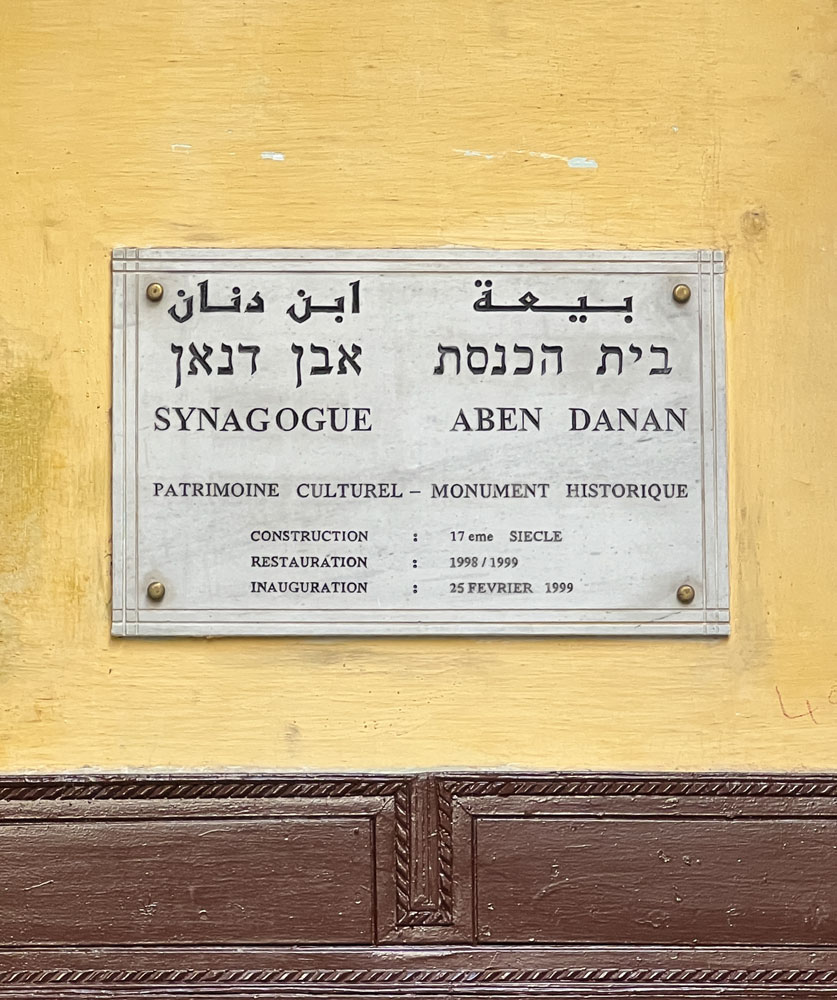
The entrance to the synagogue. Note the police officer to the right of the door. They provide protection to the synagogue. With the small number of Jews left in Morocco, I suppose the Jewish community no longer can provide security.
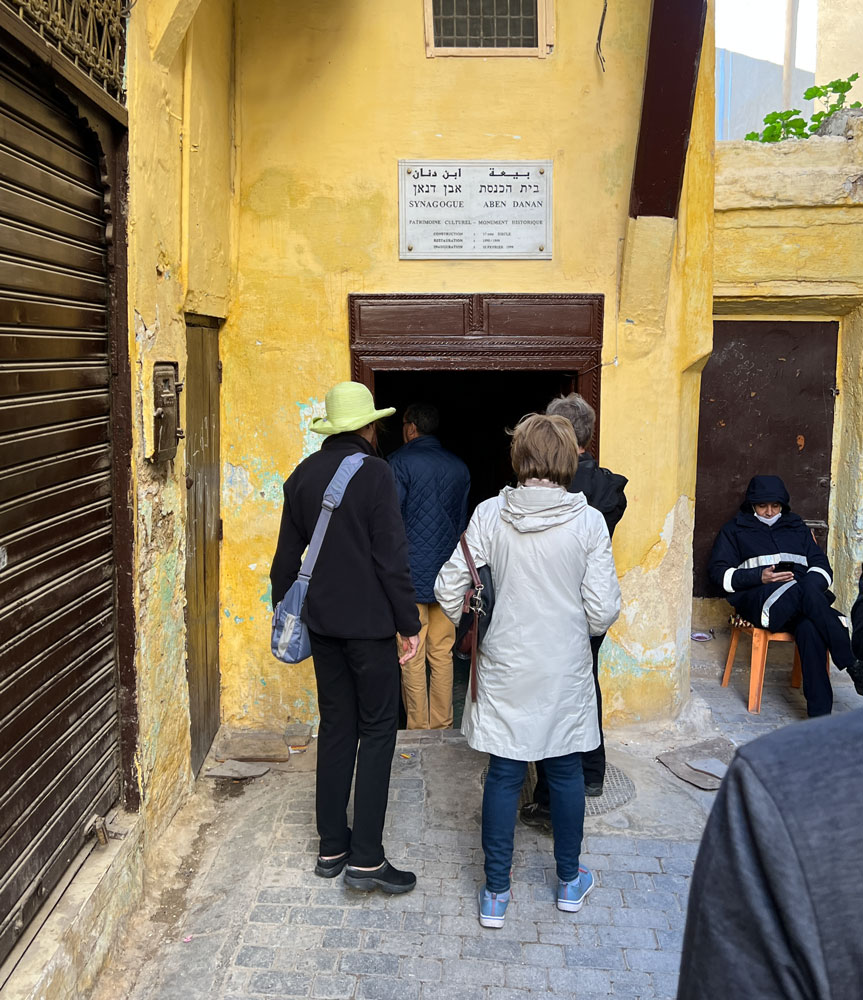
An interior view.
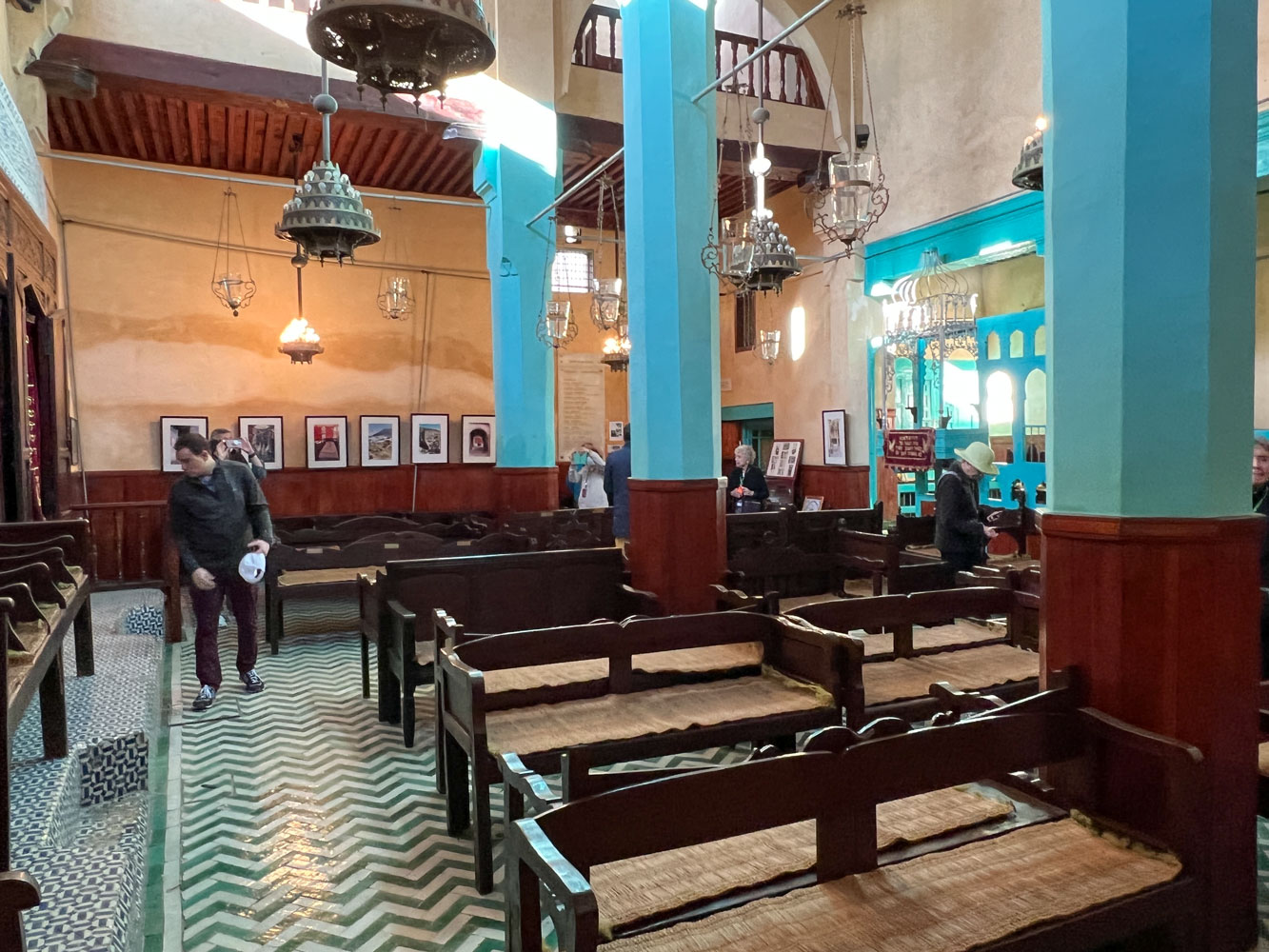
The Torah Ark.
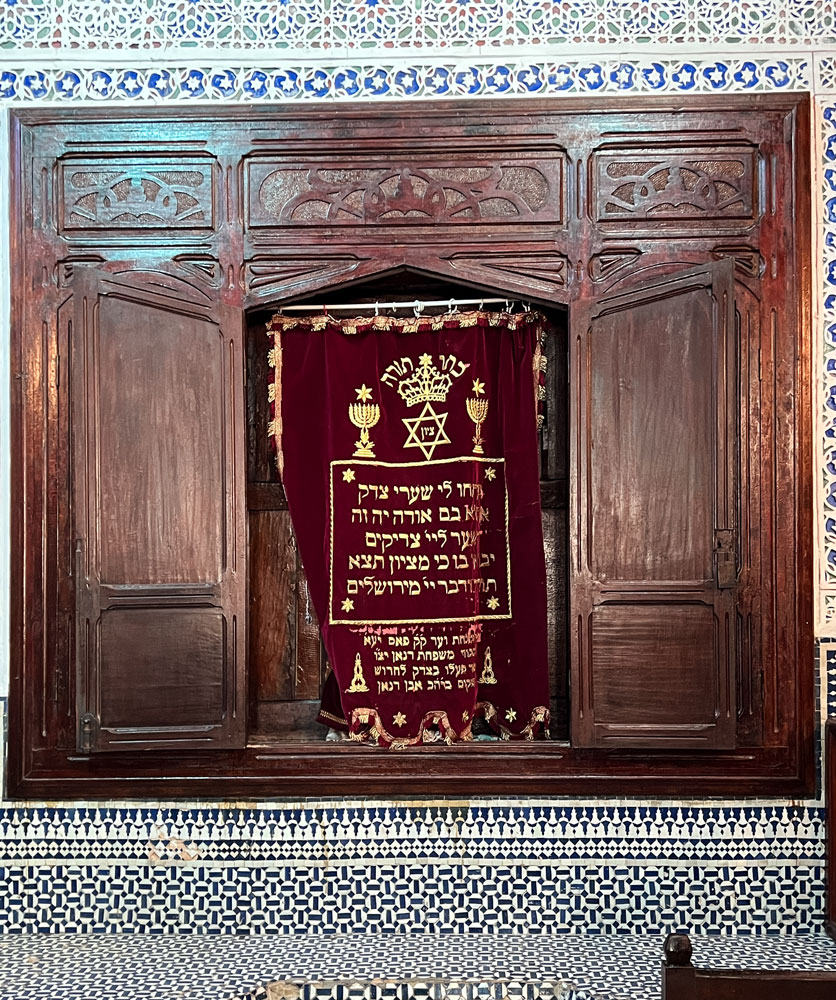
More pictures and information can be found at the link above.
We exited the synagogue and went to a different part of the medina. It was similar to where we had been earlier, with small shops selling a variety of things.
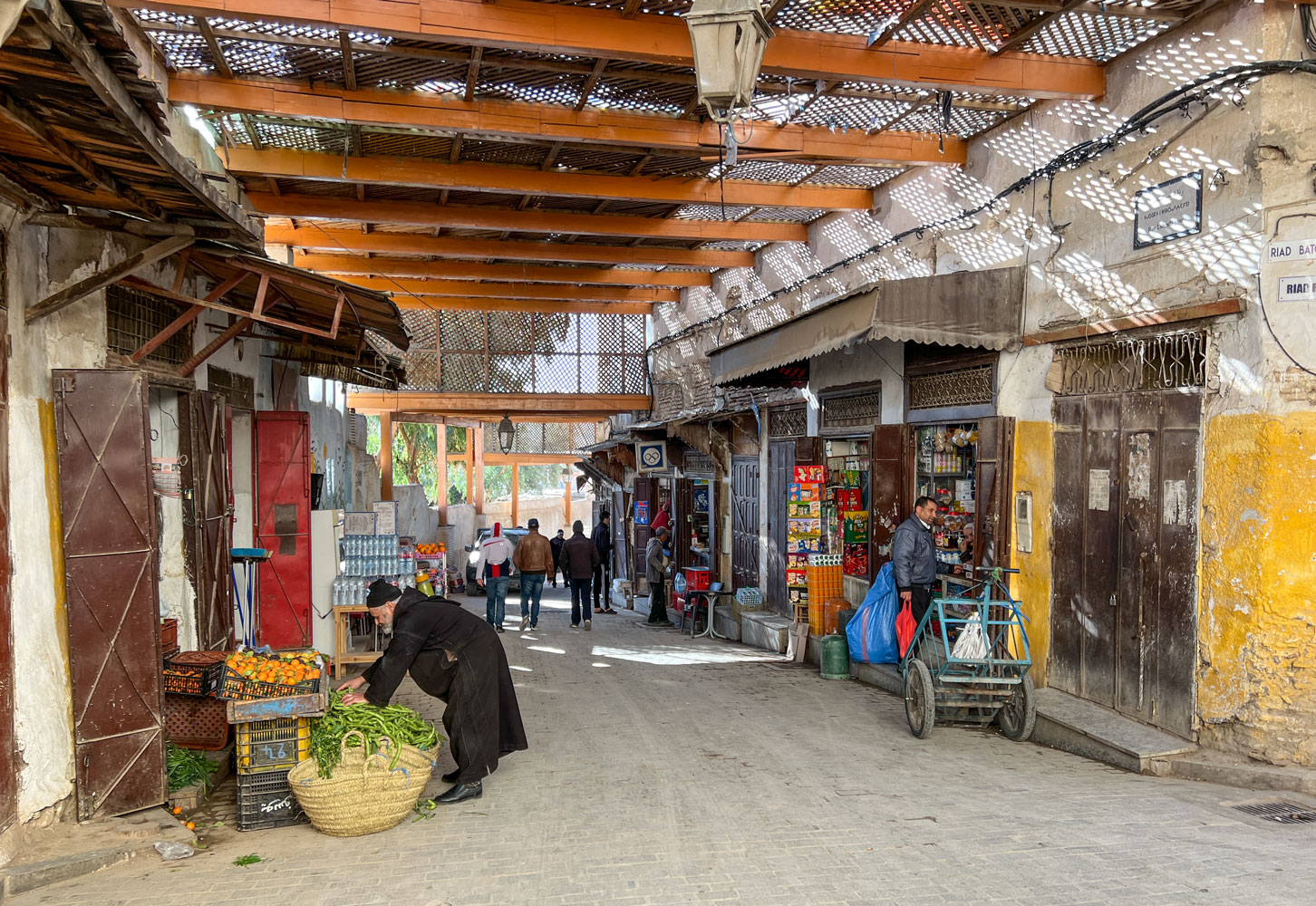
Donkeys are used to carry things in the medina because the streets are too narrow for any type of vehicle. Here are a couple of the poor donkeys. I wonder what kind of life they have.
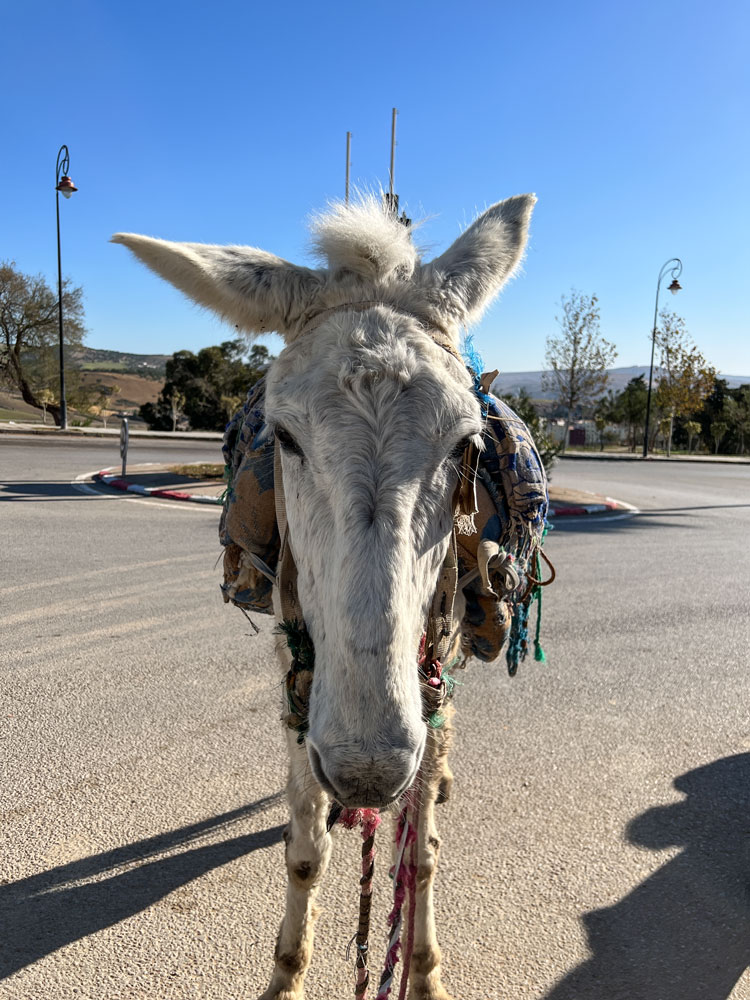
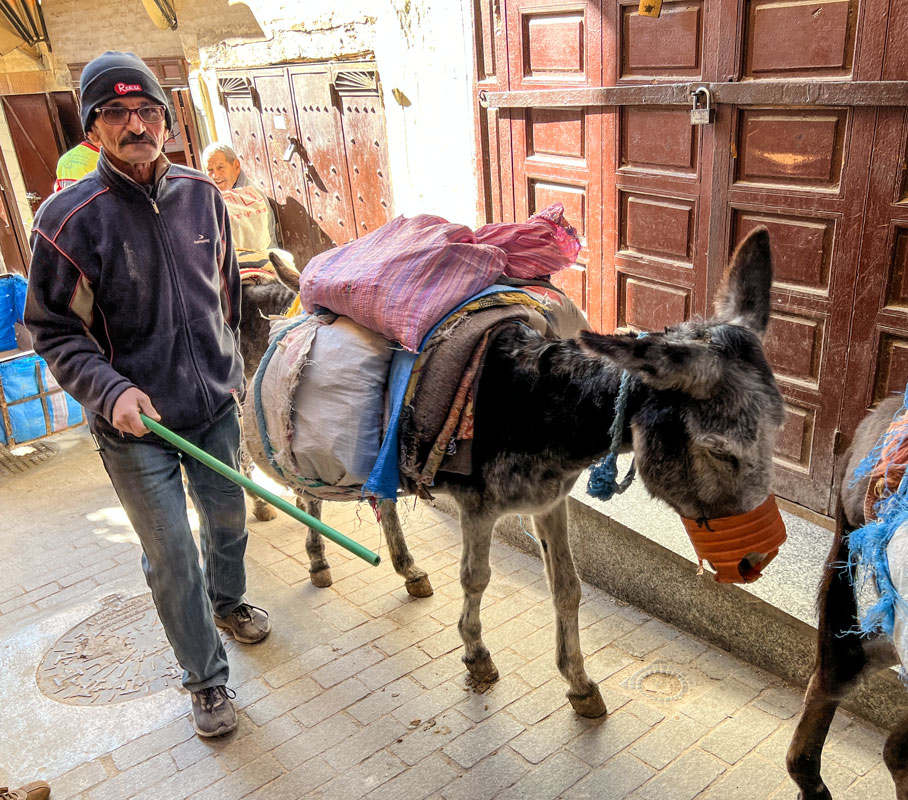
There are several donkey rescue organizations in Morocco. We were scheduled to visit American Fondouk, who provides free veterinary care for donkeys, mules and horses of the Fez medina, but we didn't make it. There are other donkey rescue organizations in Morocco. Here's one of the best known.
We passed a few woodworking shops which seemed to be making parts for the wood screens that you see in this area. Making those same parts day-after-day would drive me crazy.
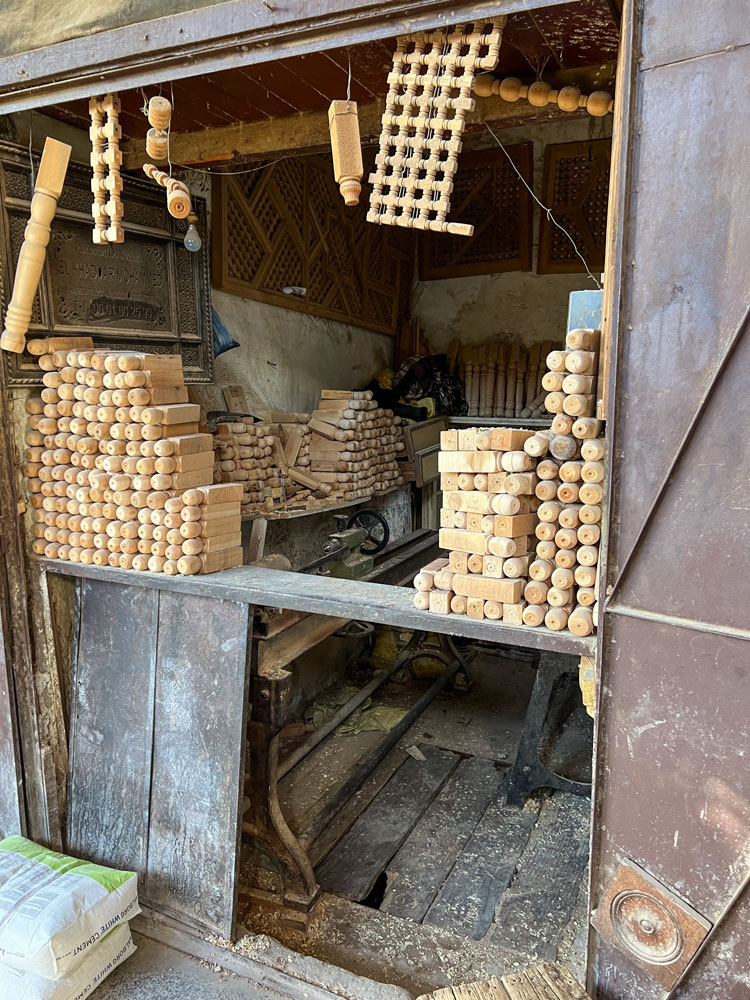
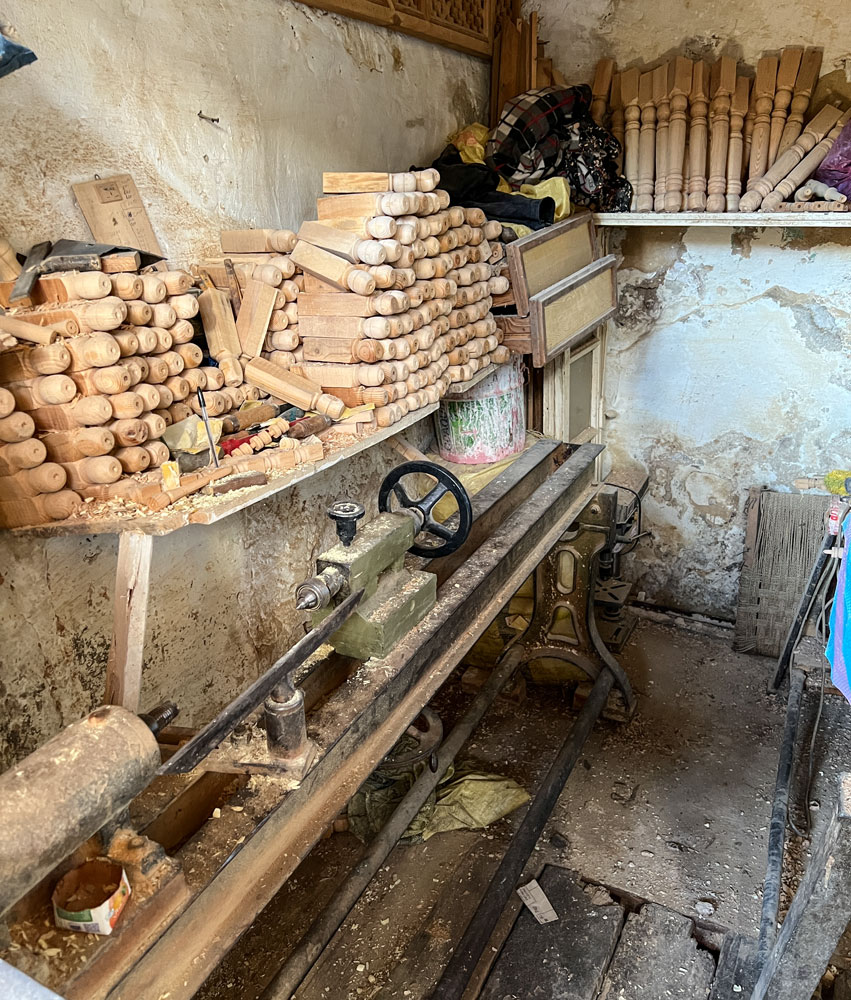
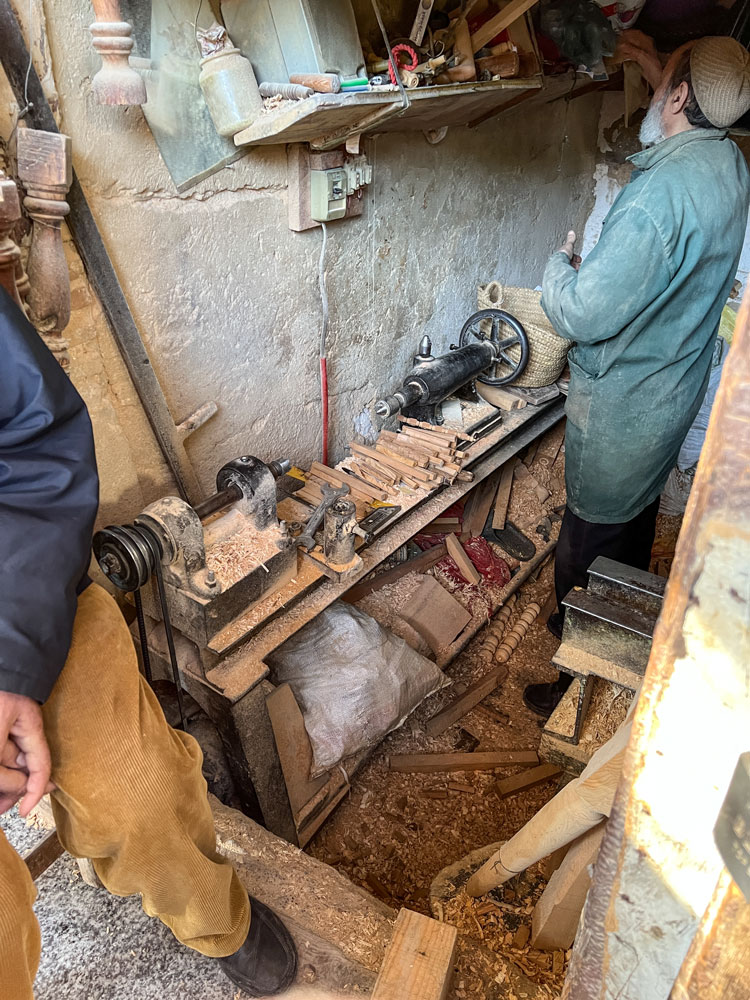
I did not see any signs of furniture making itself, just the small parts.
Here are a few pictures of the souk in the medina. These pictures cannot even come close to the experience of being here. There are so many shops, selling everything that you can imagine. And so many streets (alleys) in the medina. If you were to wander through the medina, you might never find your way out again. Our tour guide joked that he could go in the medina to visit the grandchildren of his early guests who had gotten lost in there some years ago.
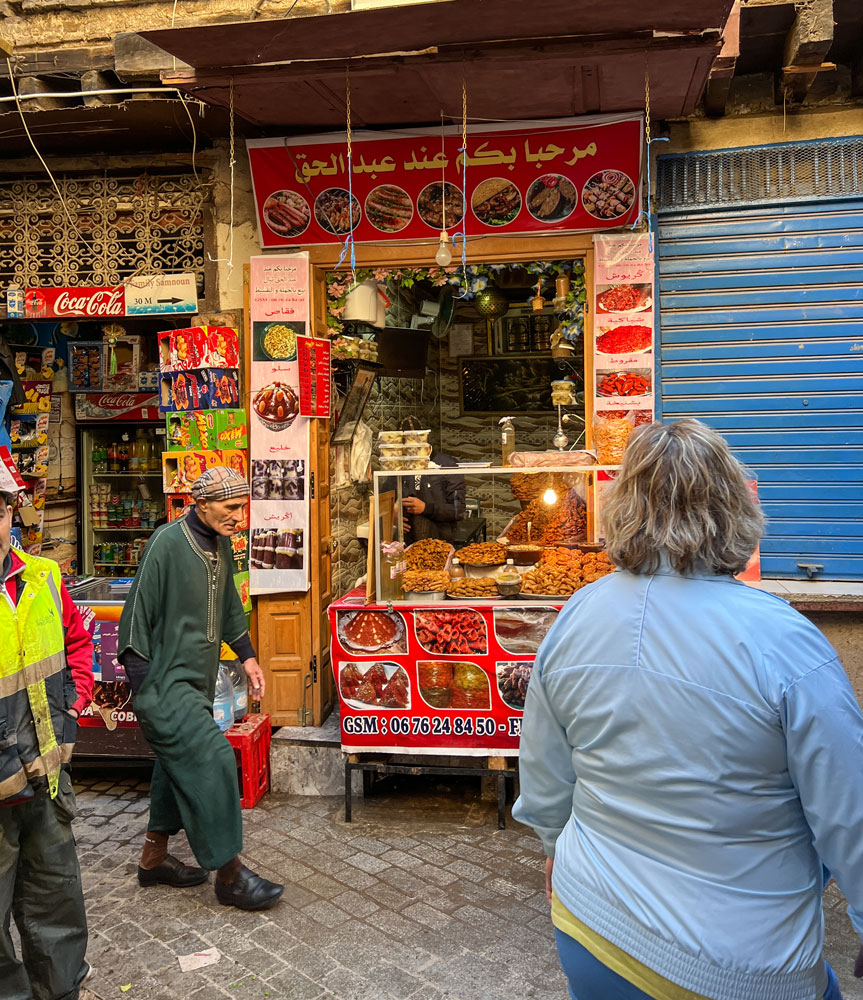
A meat vendor. He'll cut to your specifications.
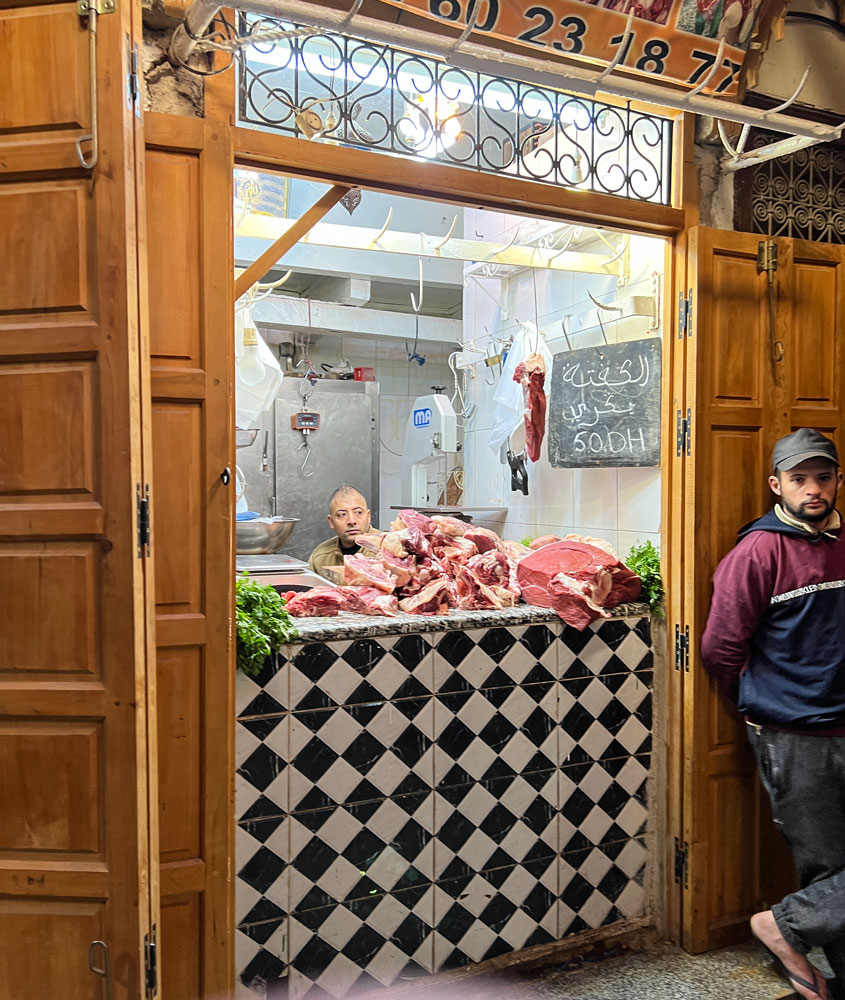
A view down one of the alleys.
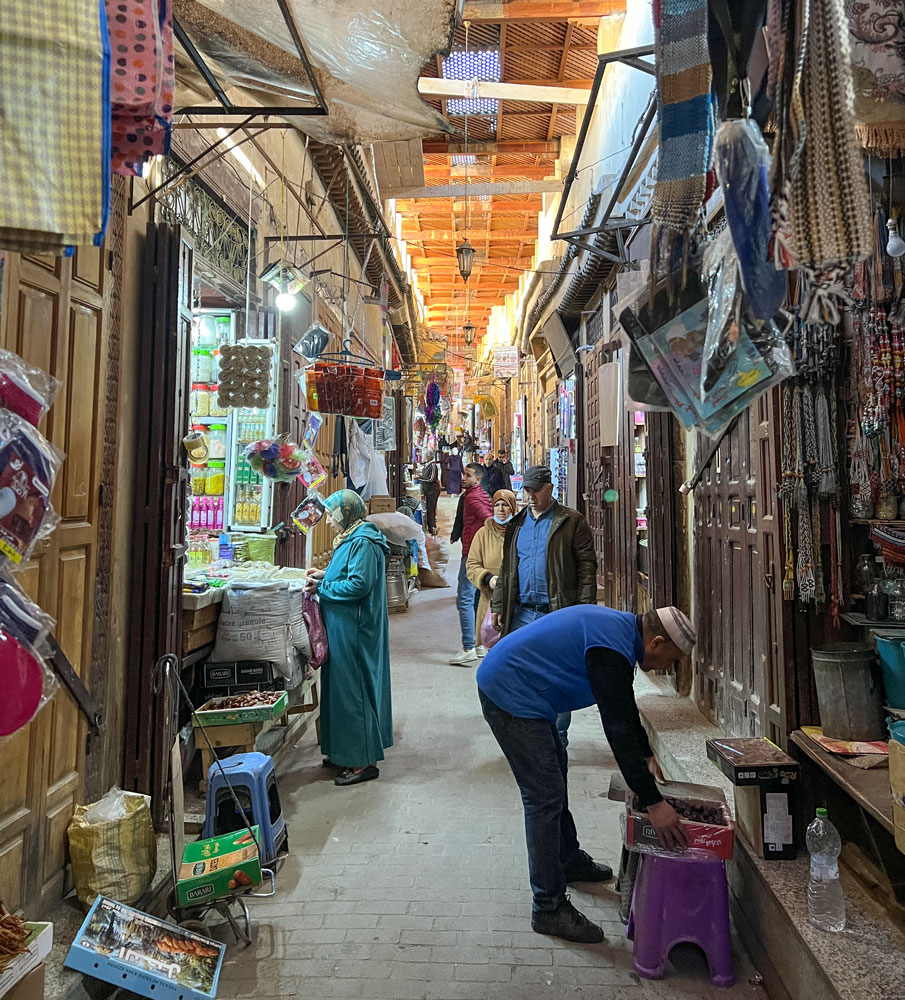
An overall view of an area.
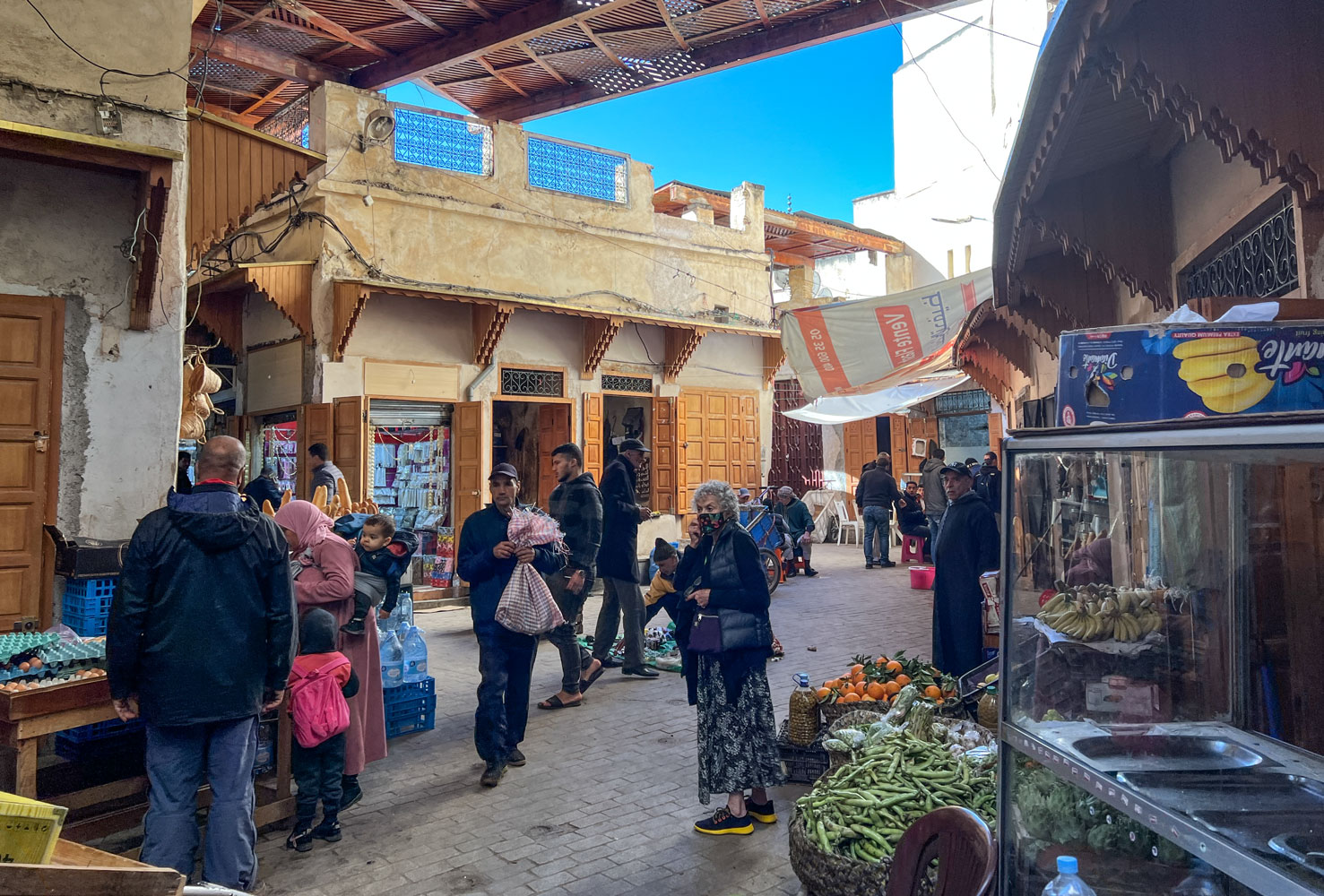
Some formal, traditional dresses for women.
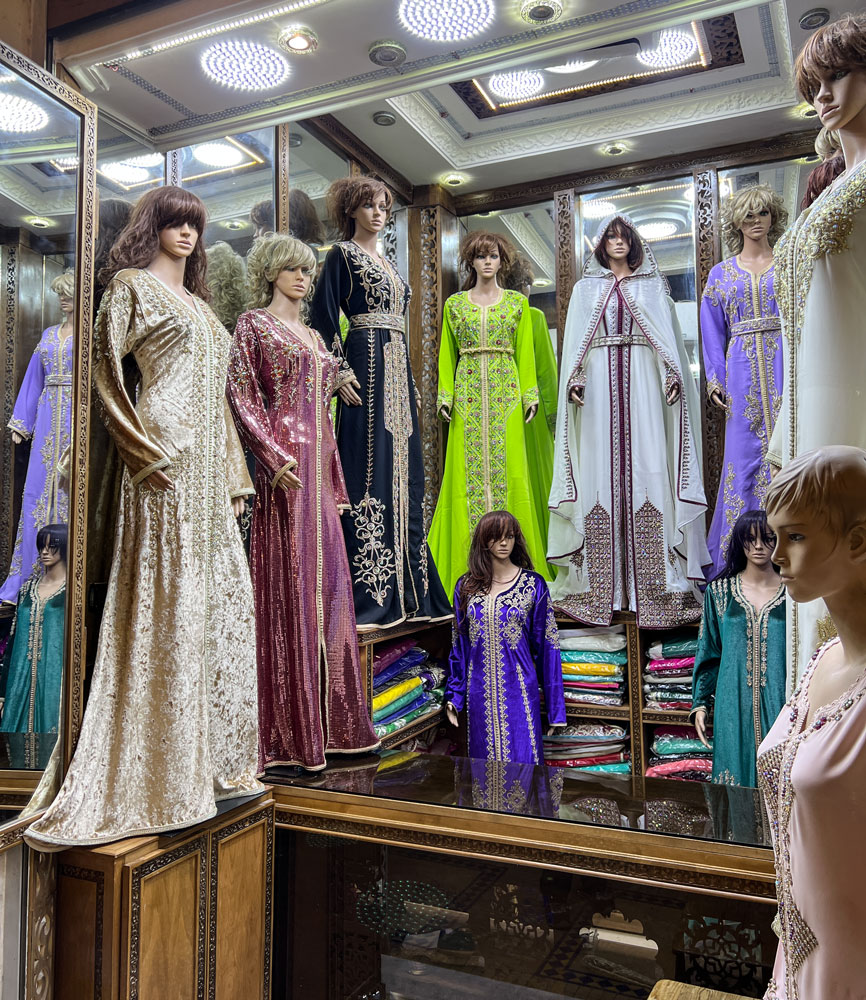
Eventually, we went to a rug merchant. His shop was large and very modern. It had been a residence and was restored by the merchant. Going to a rug merchant in the middle east is an experience. It always starts with some "social" time, where the merchant's staff serves you some drink - here, Moroccan tea - while the rug merchant give you a pitch about his rugs, and about how honest he is and that there's no discount. Eventually, his staff begin bringing out rugs, usually very large and expensive ones first. If no one bites on that, they bring out smaller and lower cost rugs.
The staff is very efficient - they scurry around laying out rugs and then picking up those which don't get any interest.
The ones shown here are mostly Berber, and were in the middle price range.
They will ship the rugs via a reputable shipper, such as FedEx. They are reliable - you'll get your rug.
[Added note: I found that the same type and design of rugs were less expensive in India than in Turkey - a little over half the cost. However, you don't have much time on the Tauck India tour to shop for rugs. Our interest was primarily in silk rugs so my comments may, or may not, apply to the wool rugs. I didn't price wool rugs.]
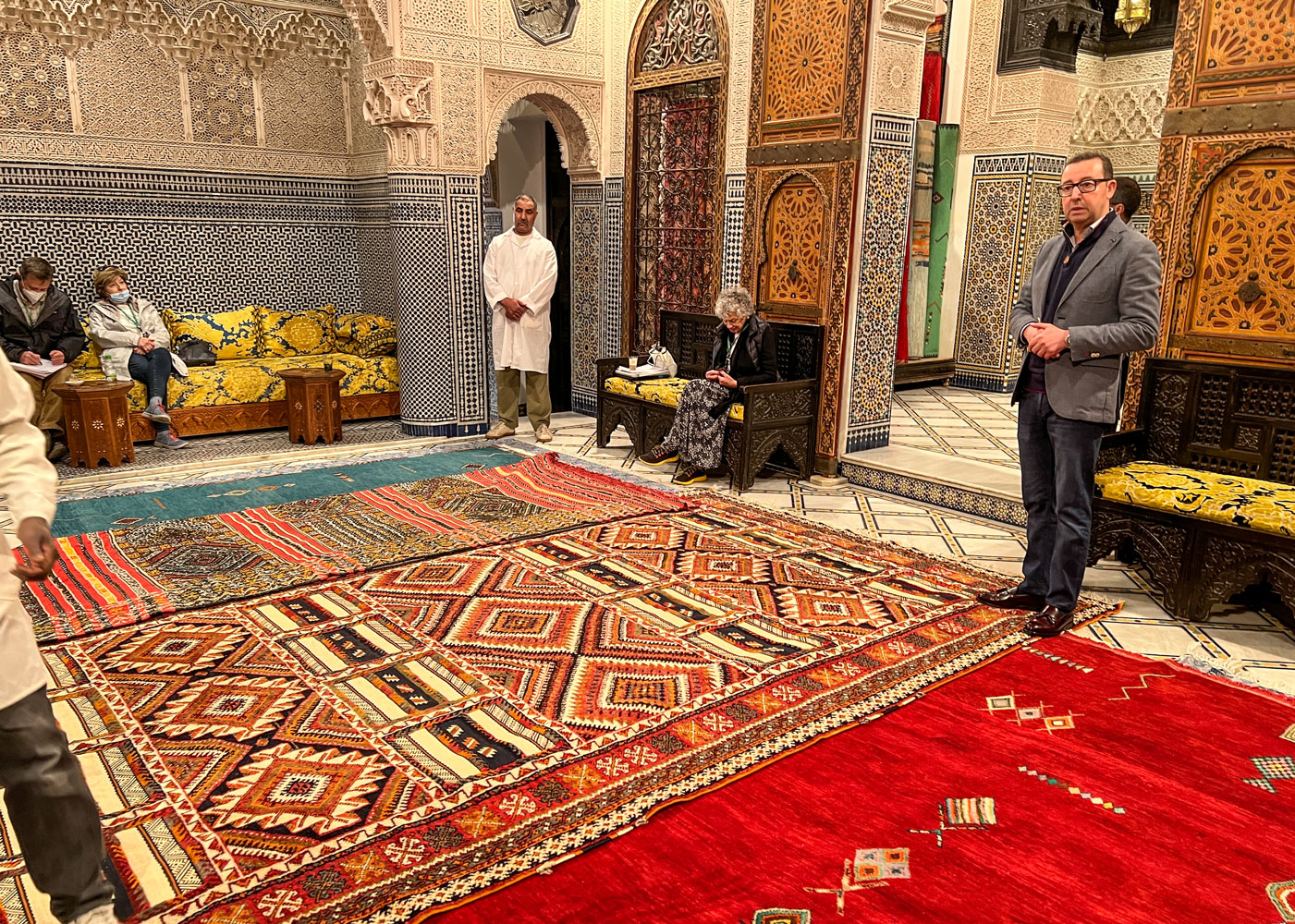
Eventually, they got to the small rugs.
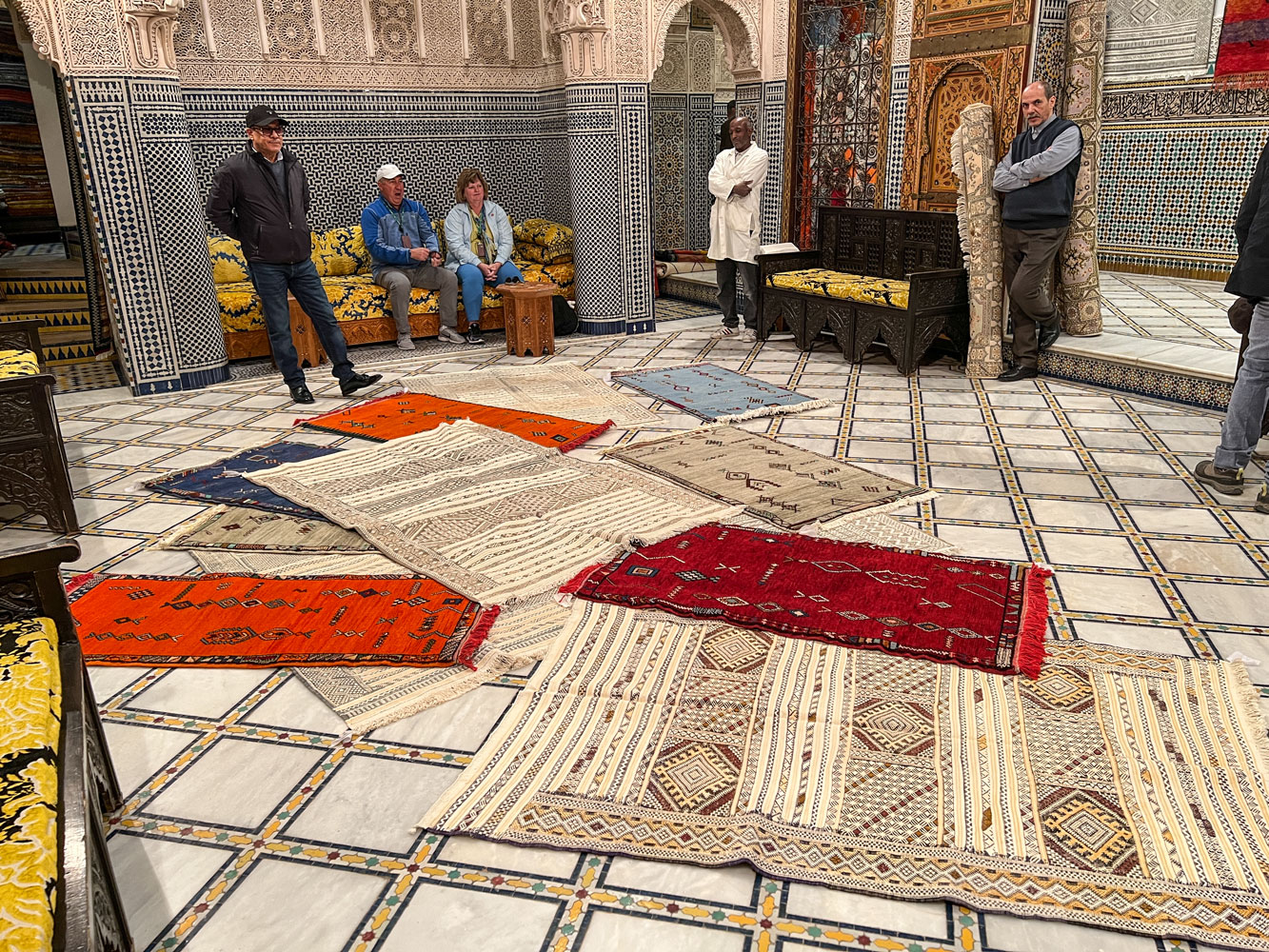
The advantage of the smaller rugs is that the buyer can carry it home. Janet bought a rug. Here she is signing the paperwork. They rolled the rug up tightly and sewed it into a covering. They even put a handle on it and delivered it to the hotel for her. This photo also shows an example of the incredible variety of tile work on many walls and buildings. Moroccan tile work is highly decorative and always has a geometric design. Its against the Muslim religion to exhibit actual items or people, since only God can create perfection.
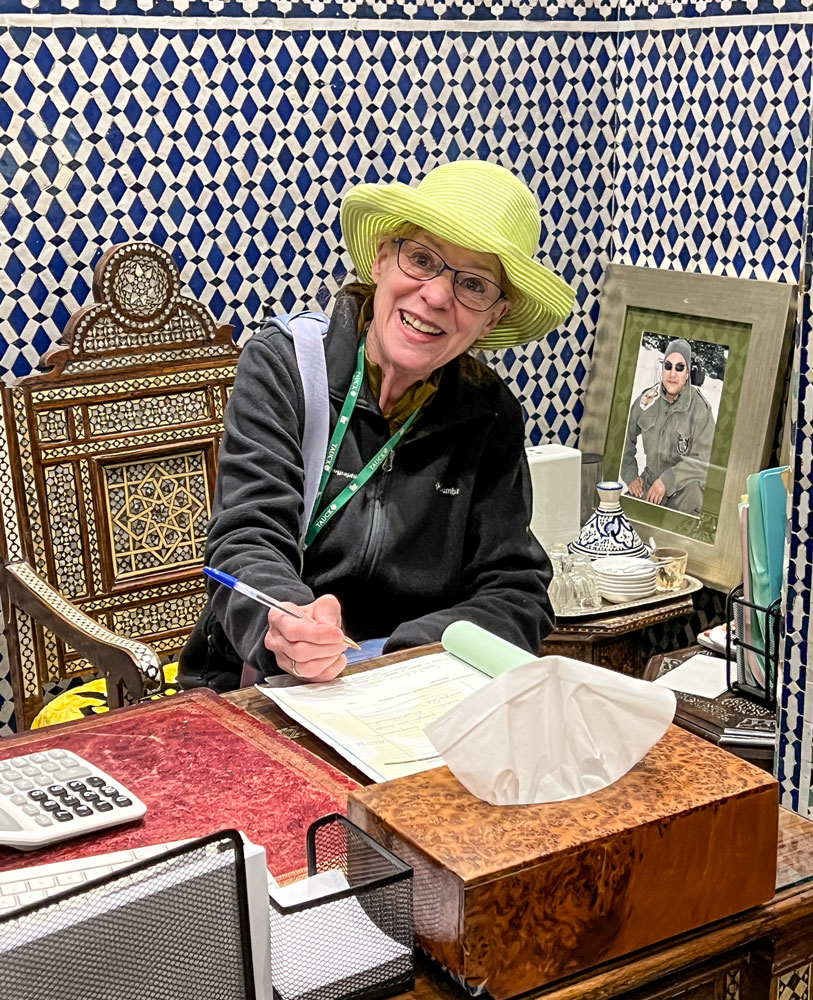
After we left the rug merchant, we stopped to watch some metal workers - specifically copper workers - making copper platters. Dennis tried his hand at shaping one of the platters.
Note the dark mark on the worker's forehead. When Muslims pray, they put their forehead down on the prayer rug. Over time, they may develop a mark like the worker has, called a zabiba (also see here). It is the sign of a pious Muslim.
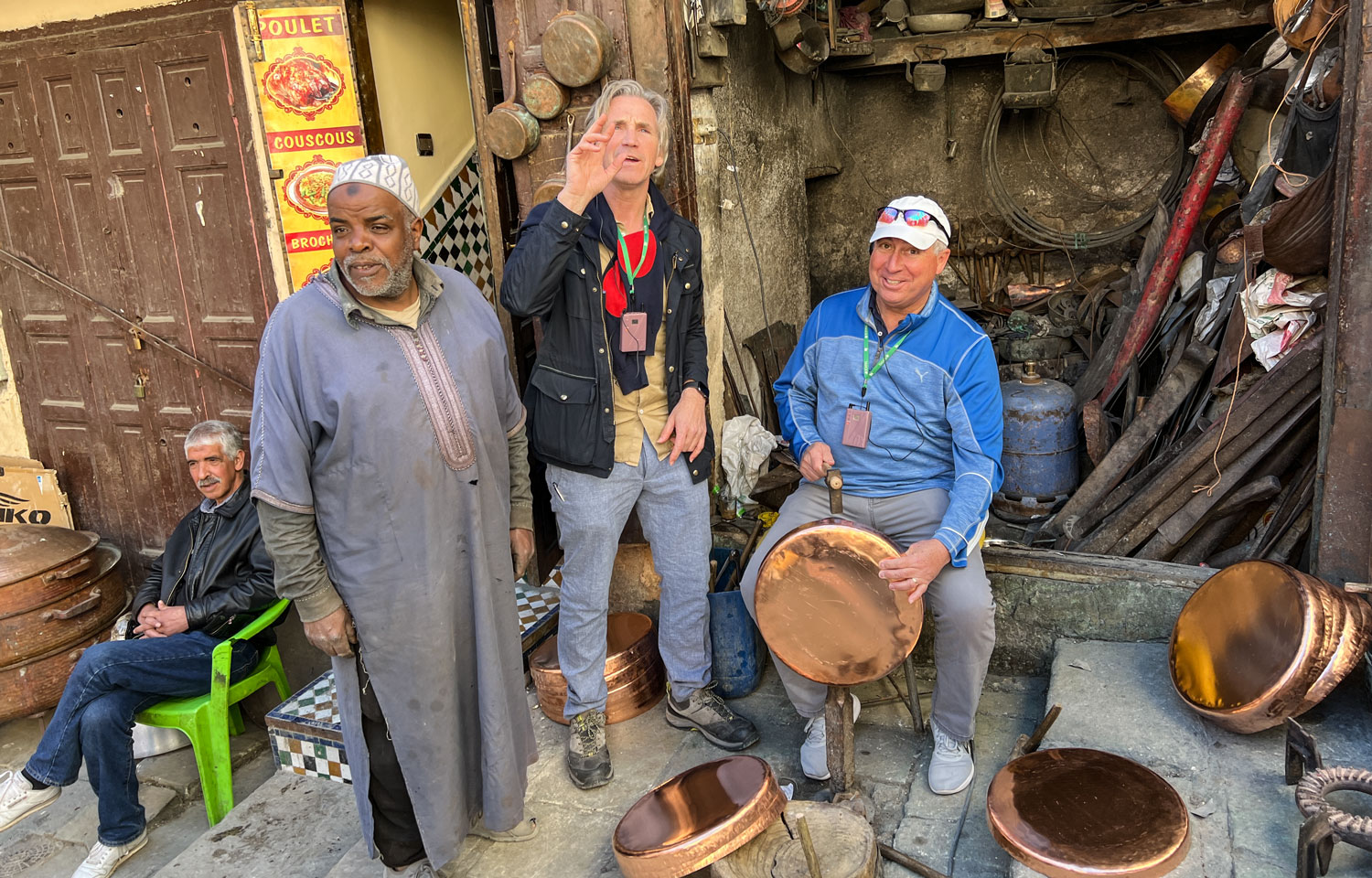
I didn't take any pictures of it, but Judy and I bought a door knocker in the shape of the Hand of Fatima, which is a traditional shape for door knockers. The one we bought is not as nice as this picture (taken from the web) but the concept is the same. Fatima was the daughter of Muhammad and is invoked for protection from the evil eye.
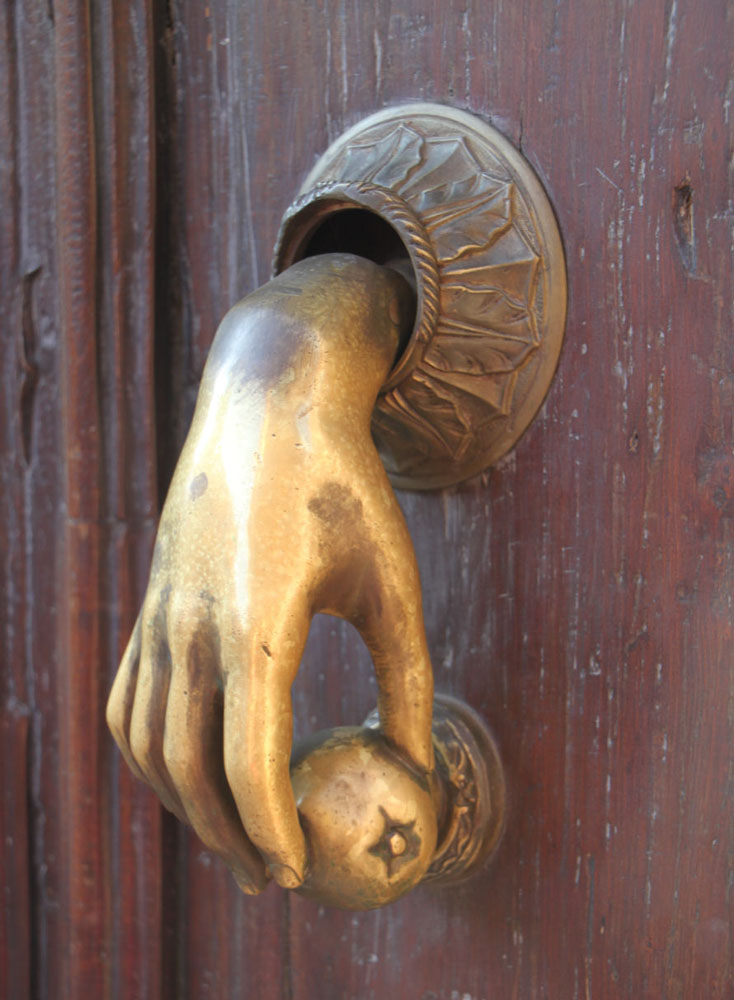
Next, we went to lunch at Palais Amani.
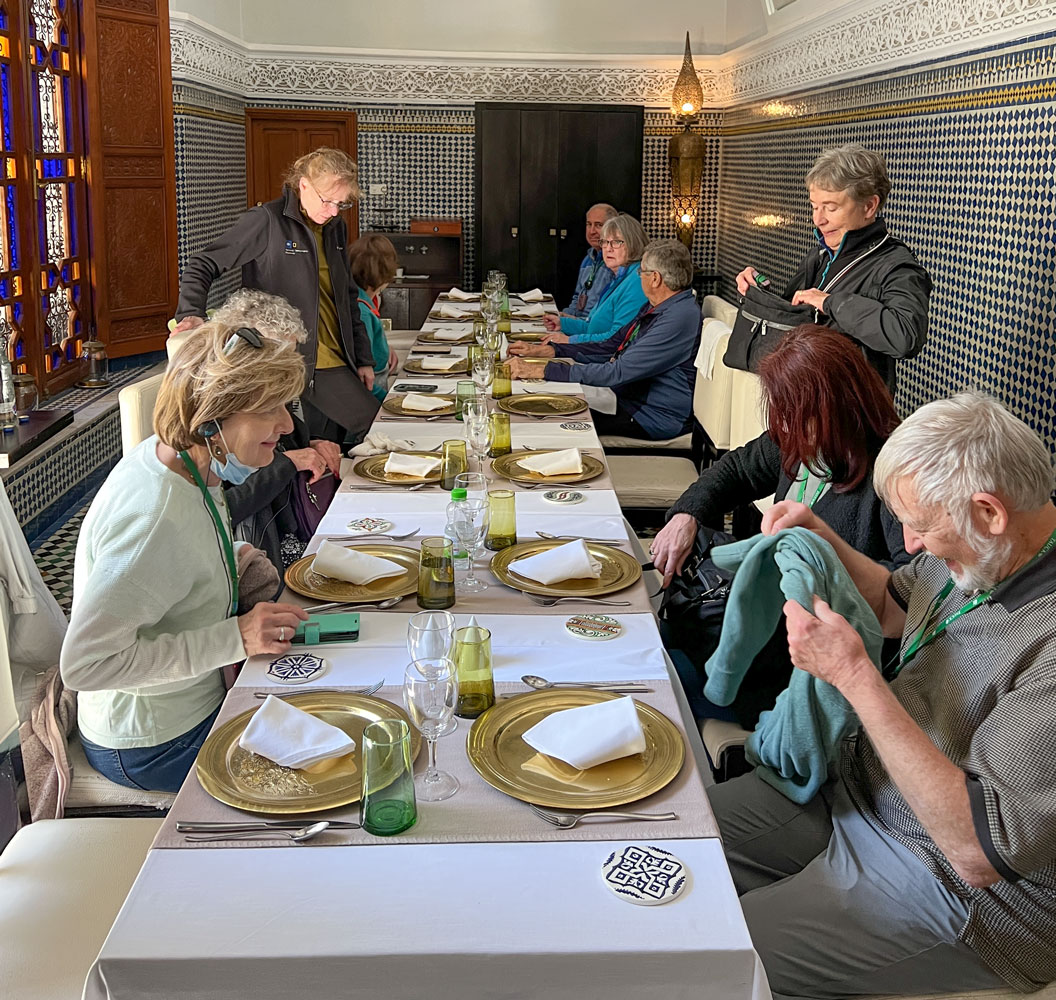
Fatima Amrani, a woman professor from the local university, came and gave us a talk about the role of women in Moroccan society and politics. Unfortunately, she did not know when to quit and went on much too long.
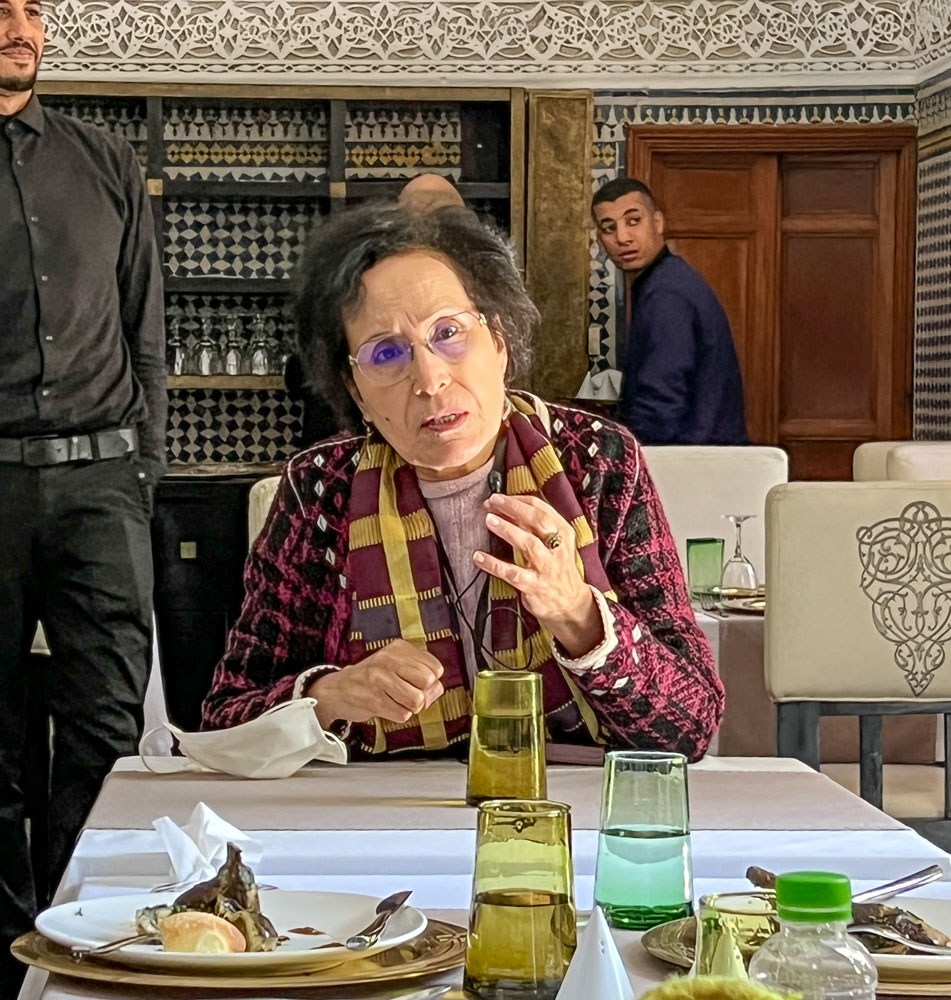
After lunch we went to the Al Attarine Madrasa, built about 1330. Nourdine is telling us about it, as the oldest school in the country.
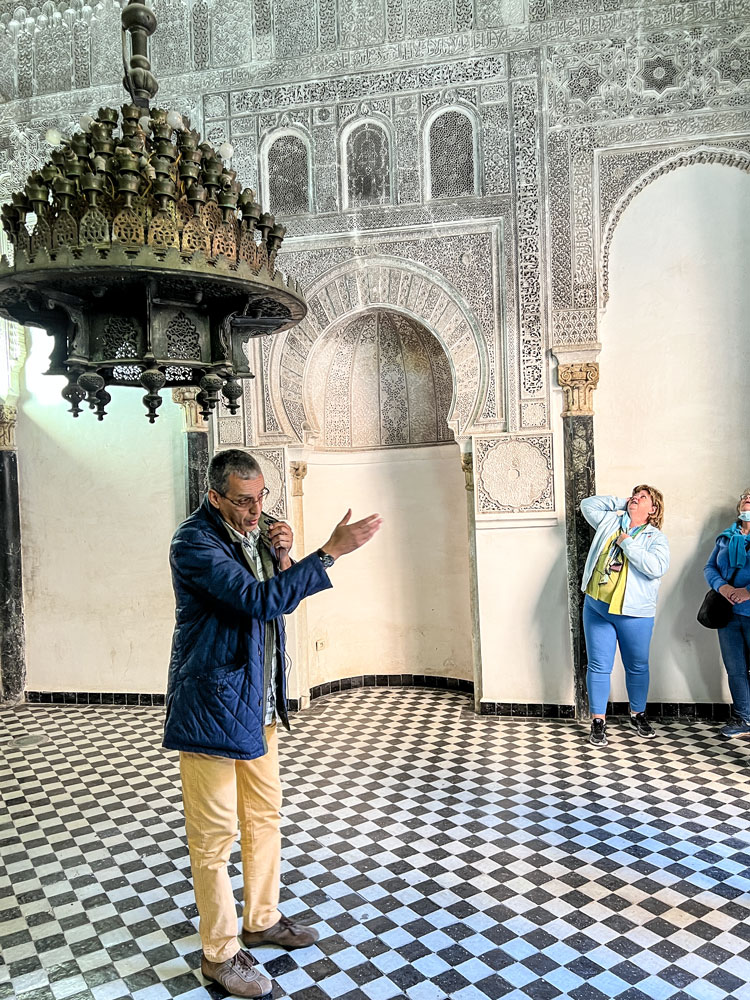
From there we went to the Chouara Tannery to learn the traditional way hides are tanned. In this picture you can see the vats where they dye the hides. Some of the processing is now done outside the city because of the smell and pollution.
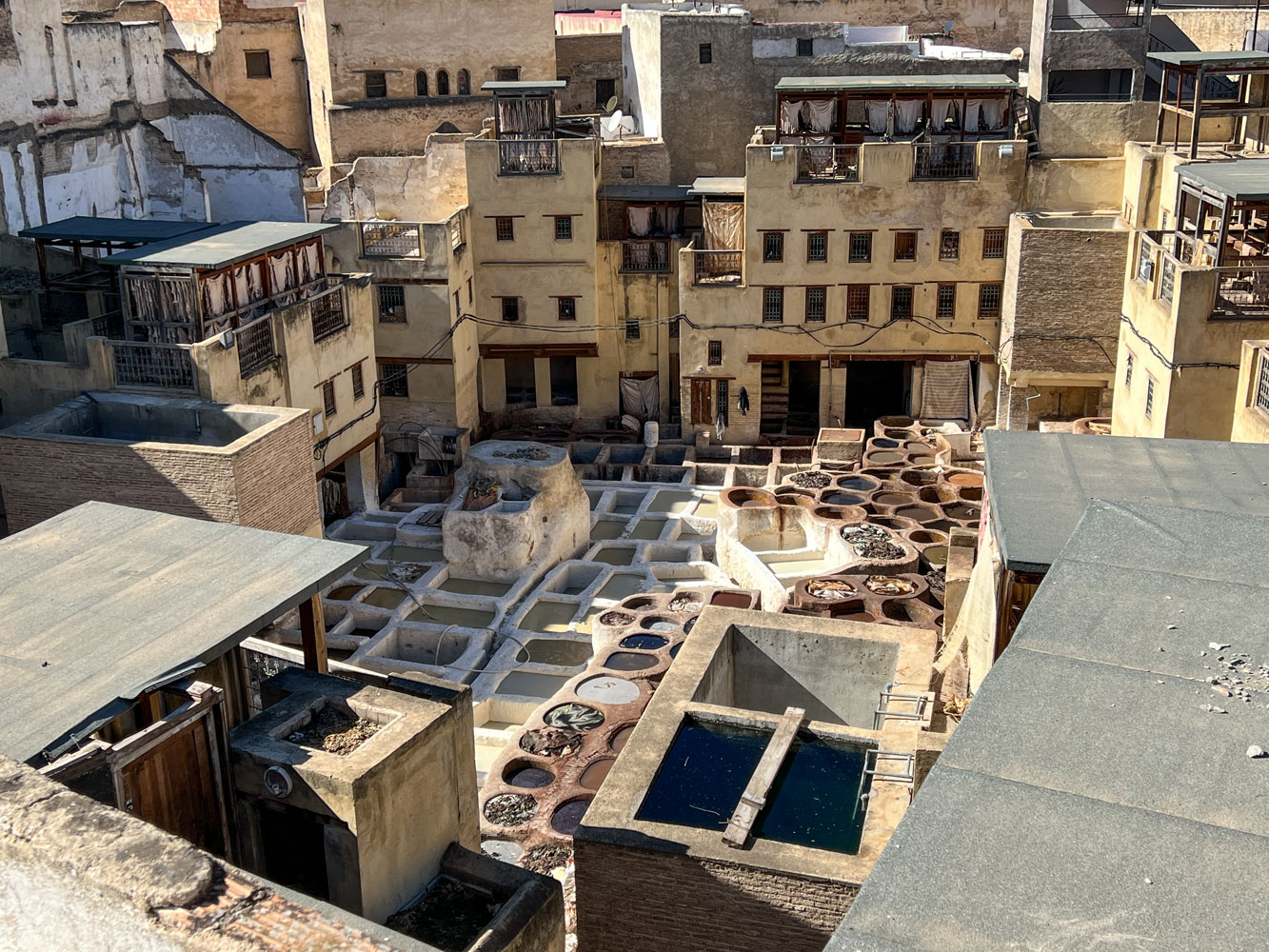
Some hides hung to dry.
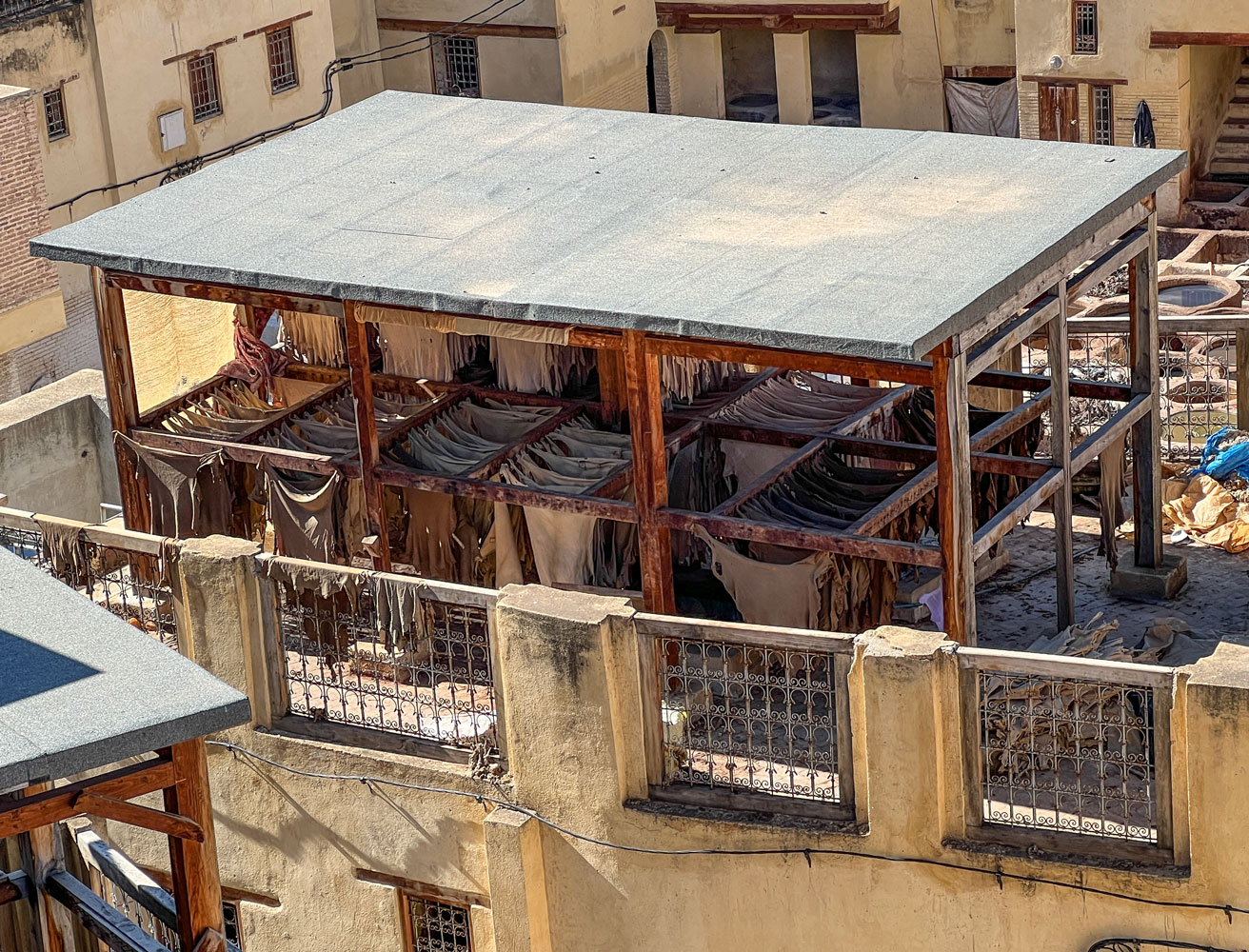
Of course, these kind of stops are really set up to sell you something. So next we went to the showroom where all kinds of leather items were displayed.
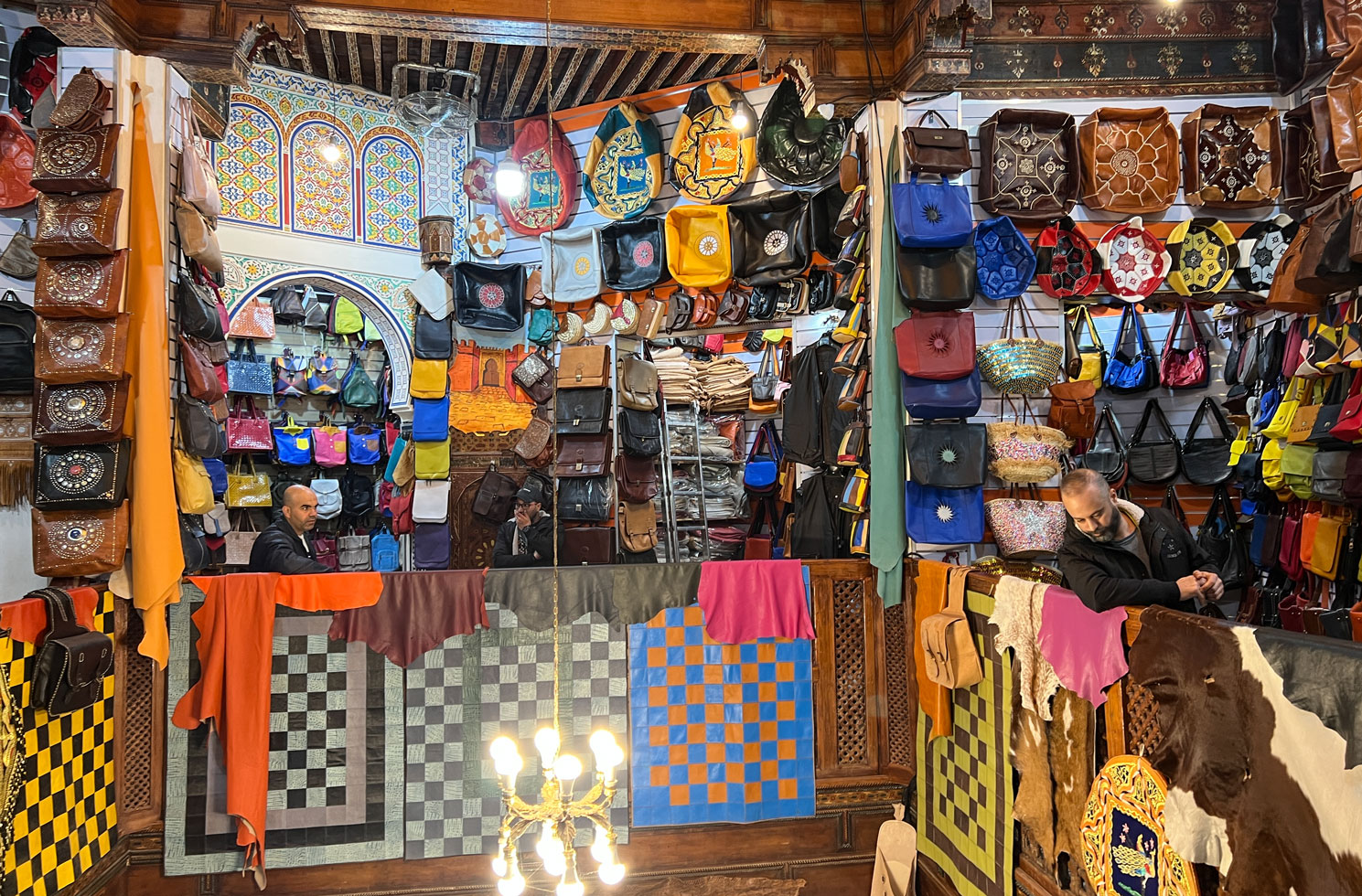
Judy and Nourdine in the showroom. Jeff and Chris are in the background.
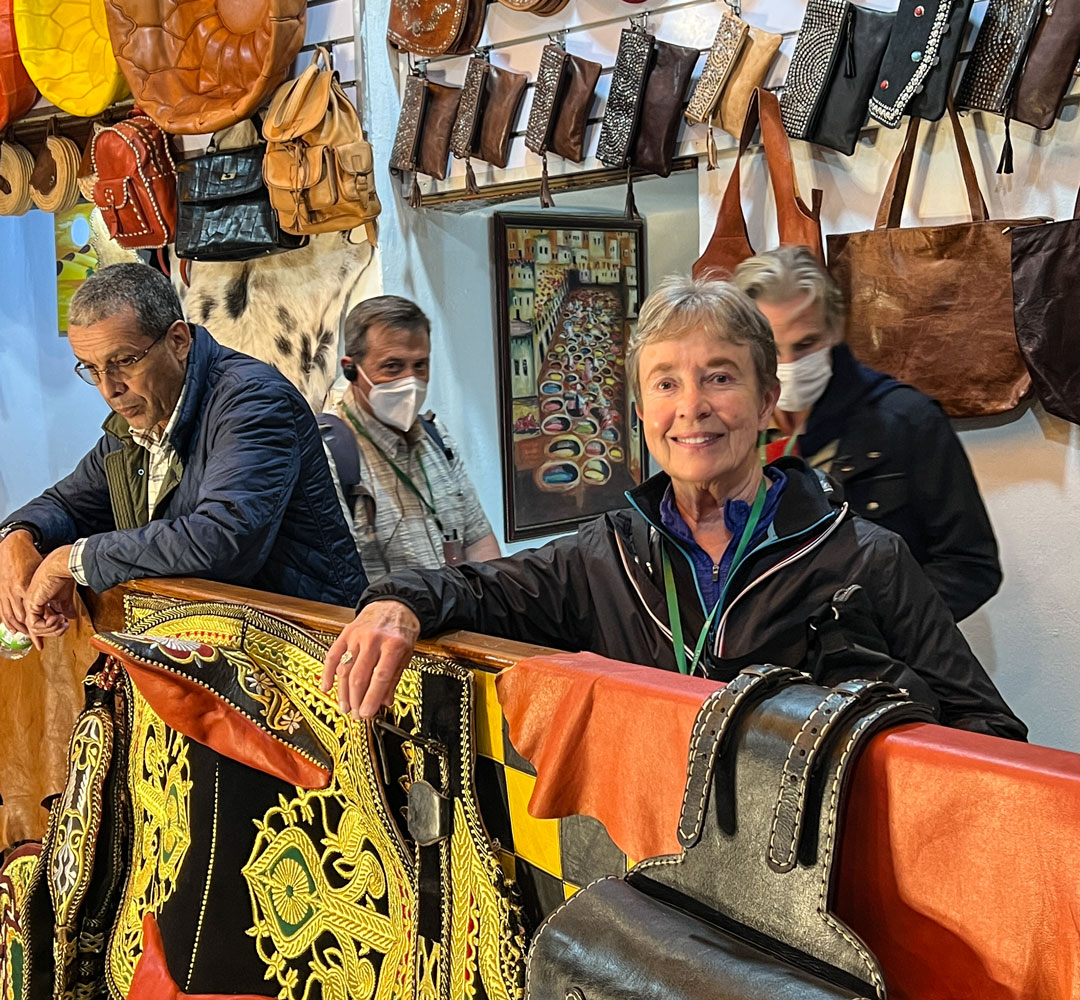
Janet found a purse that she liked, but wanted the zipper opening at the top to be longer. They took the purse, modified it in the workshop, and delivered it to her at the hotel. The work was done quickly and perfectly.
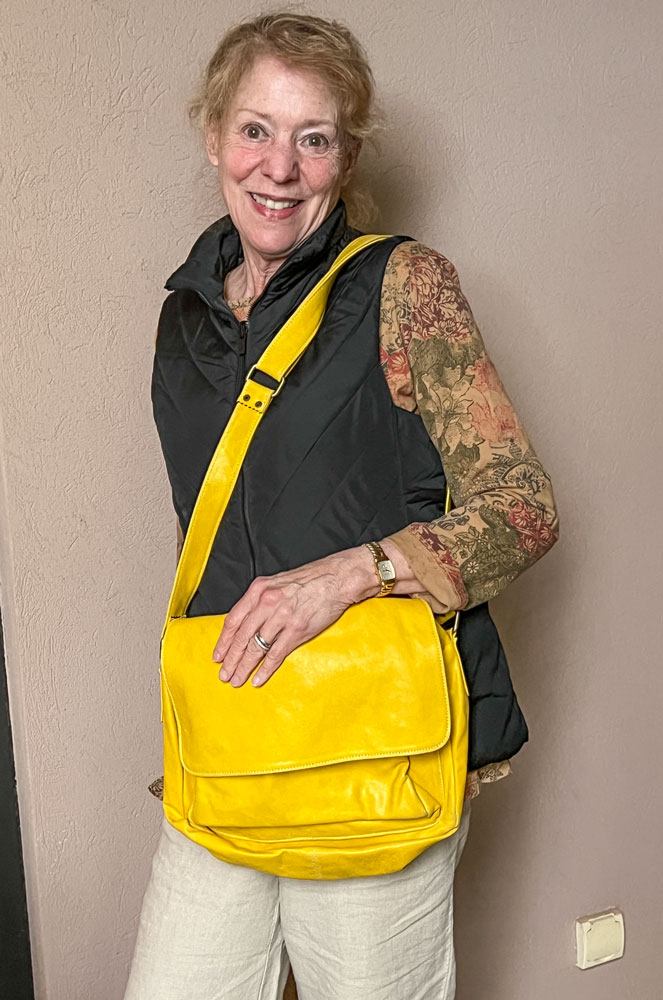
That evening, we had dinner arrangements at Relais and Chateaux, a nice restaurant within walking distance of our hotel.
Here's a picture of our group in the restaurant area.
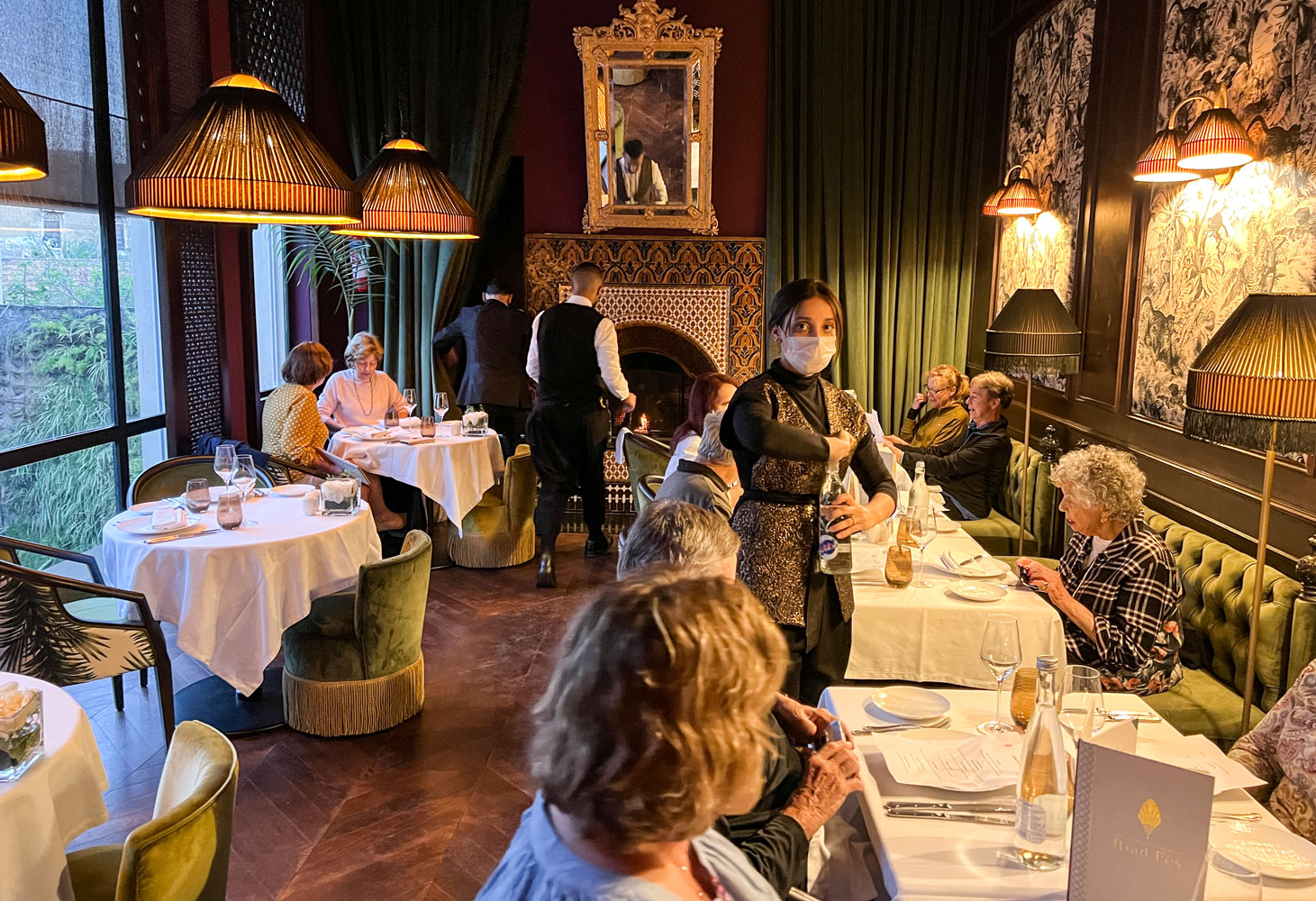
Janet and Judy at dinner. We're still wearing our borrowed clothes.
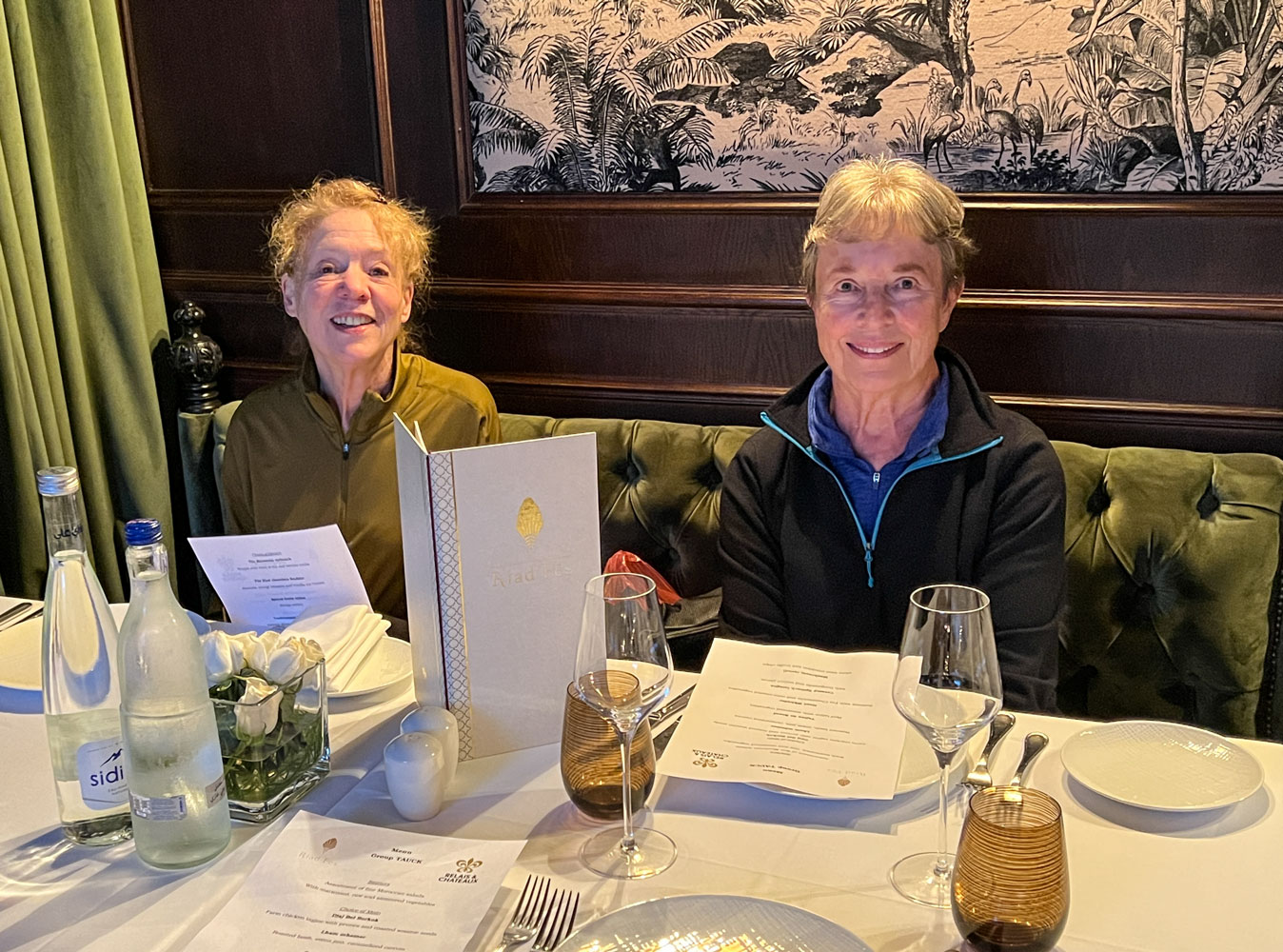
A musician who plays the oud came and to play and sing Moroccan songs.
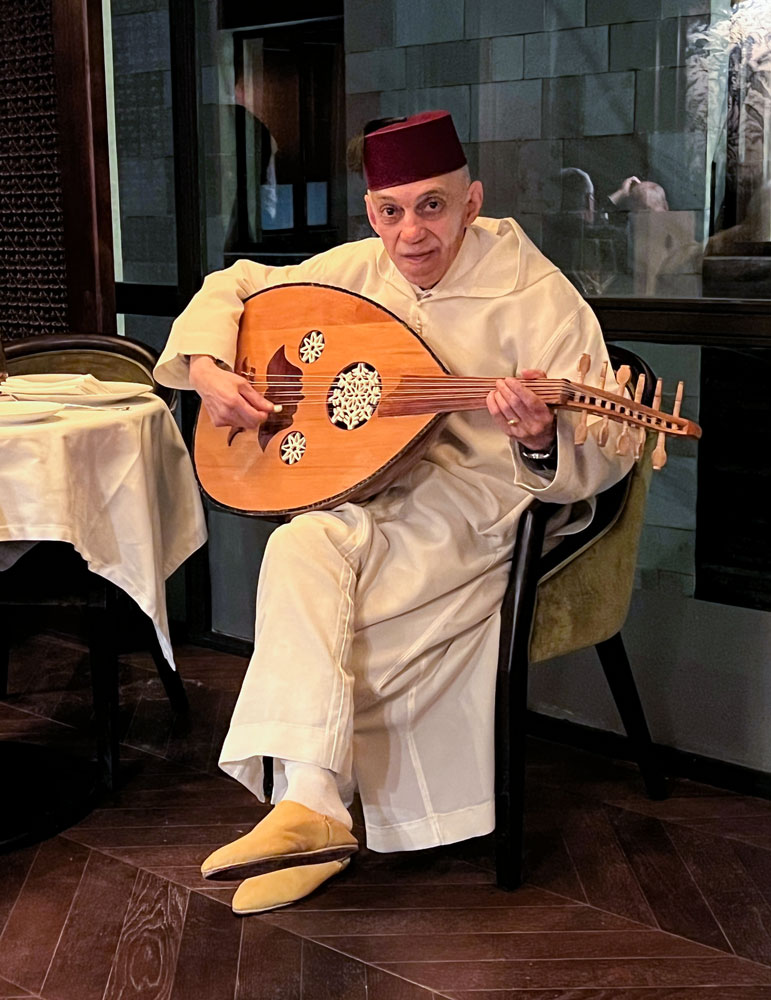
Here's a video of him playing.
He asked if anyone wanted to try the oud and both Judy and Janet volunteered. Here's Judy playing and singing a Moroccan song.
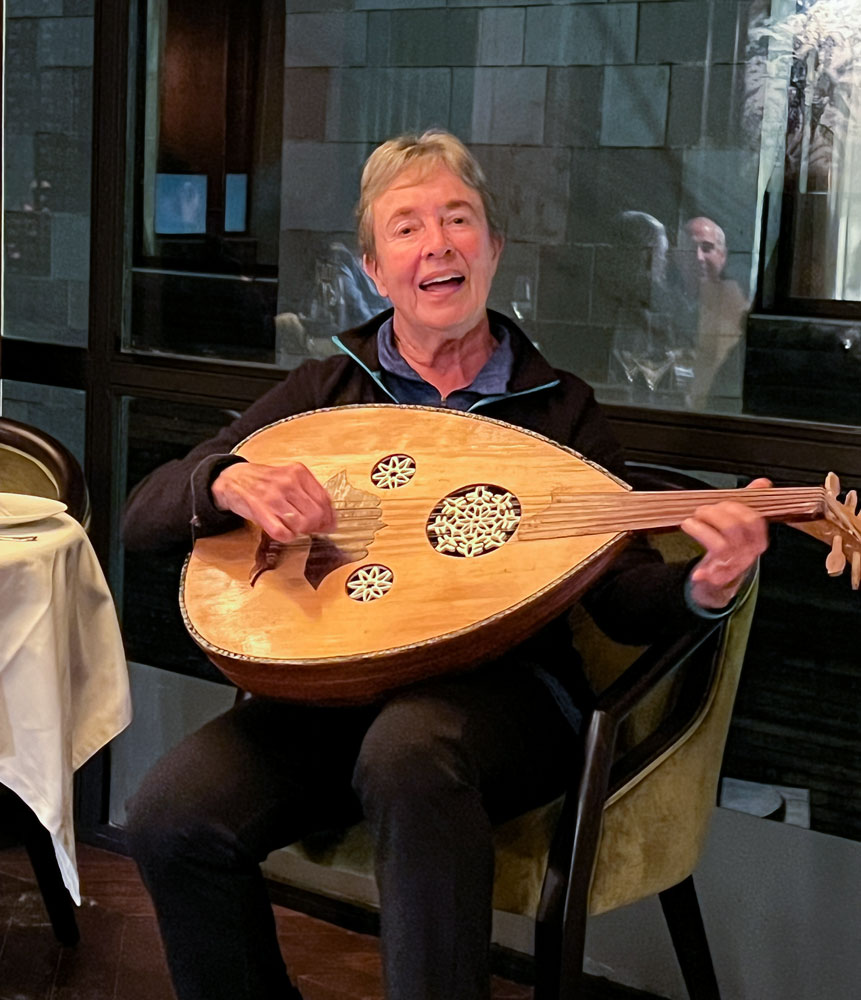
And Janet.
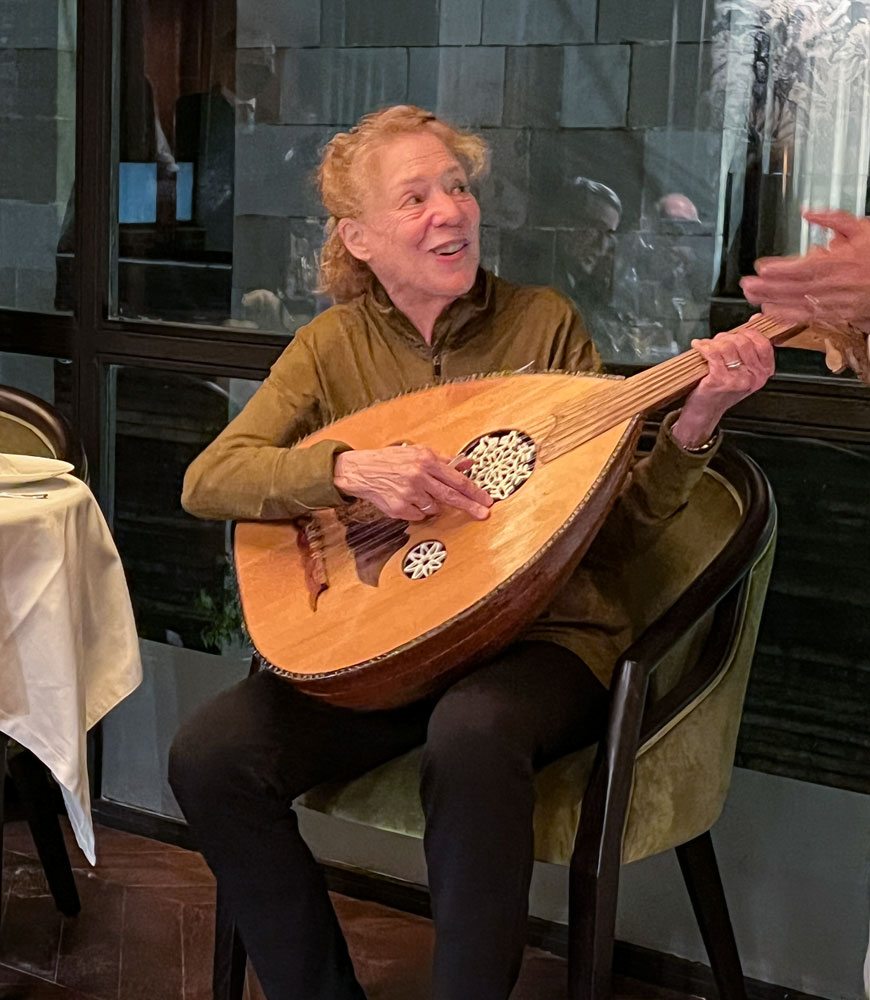
After that, we headed back to the hotel and to bed. Tomorrow we go to Volubilis.
The observant reader will notice that we haven't received our luggage yet. Stay tuned - there's more to come on that front in a future installment.